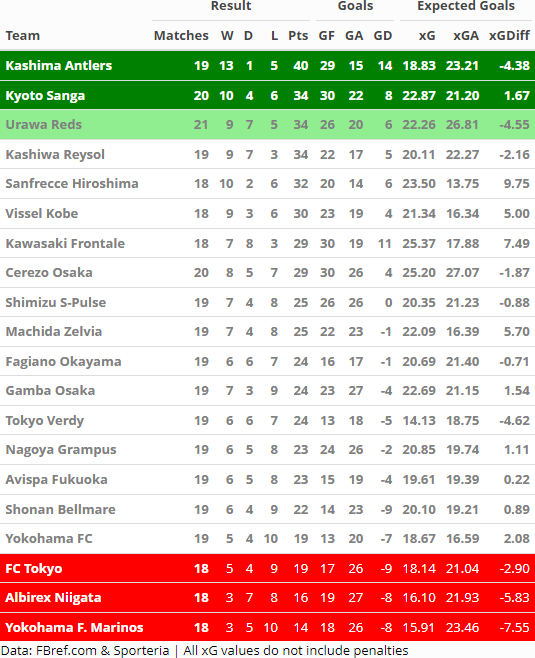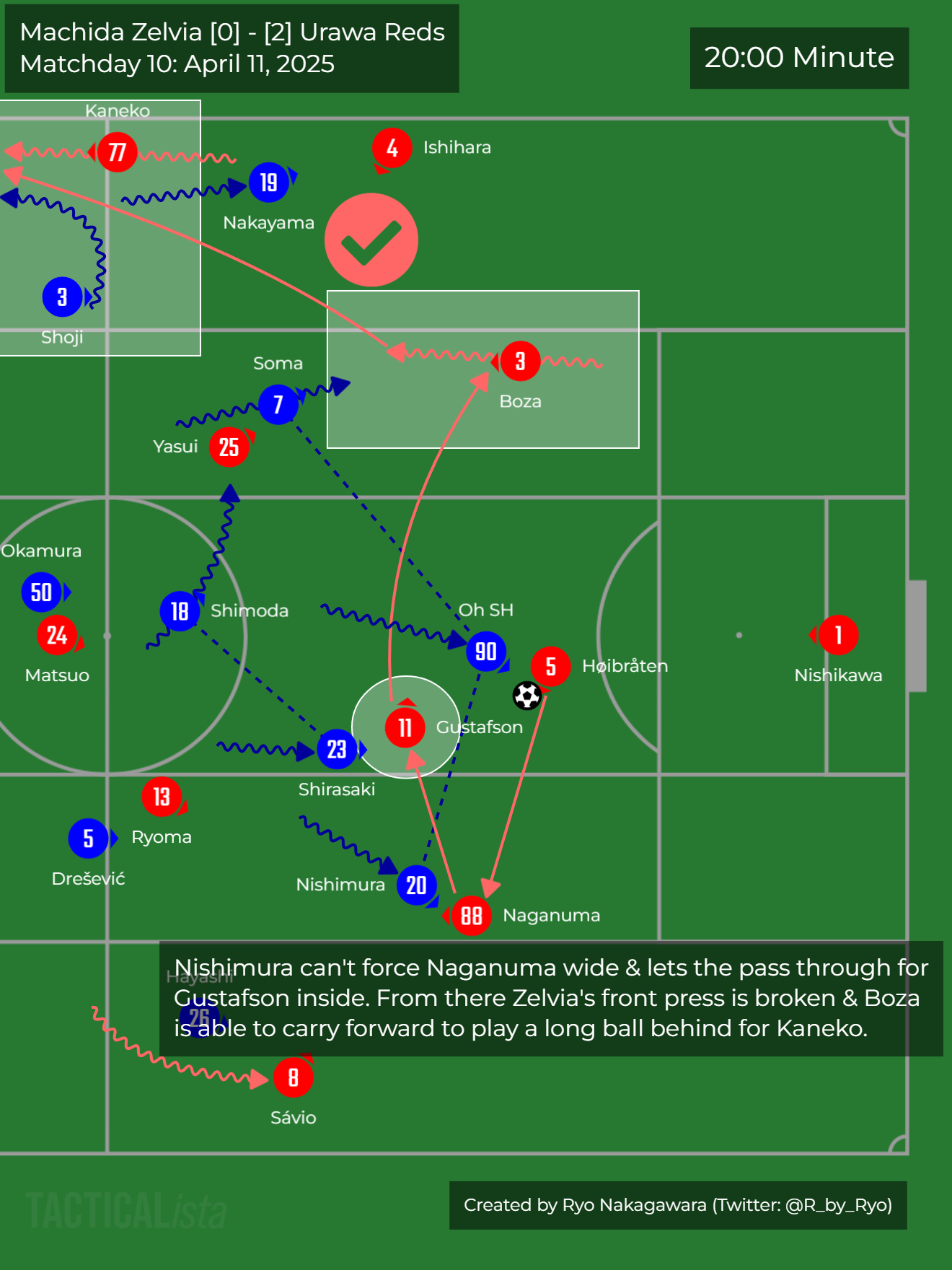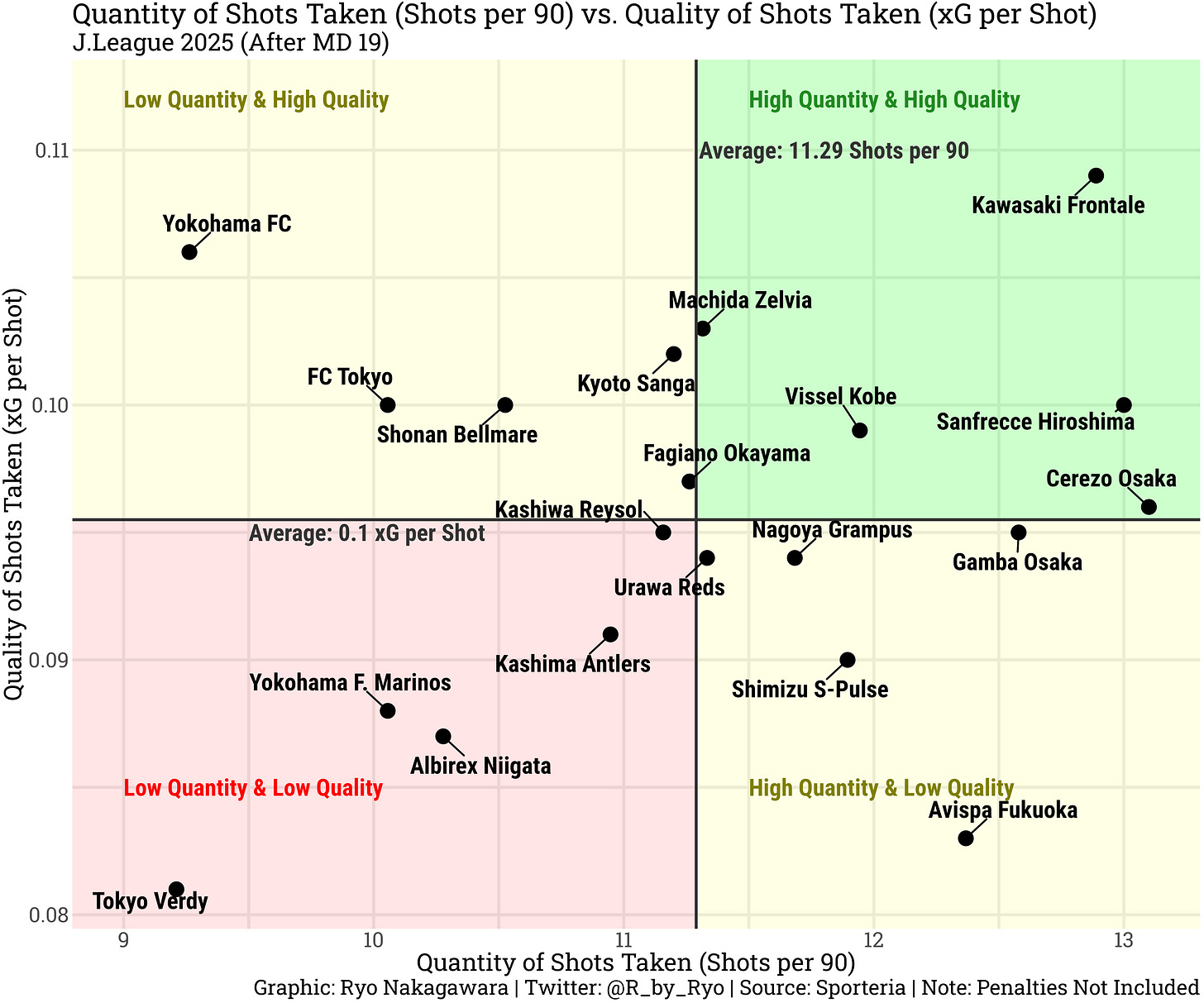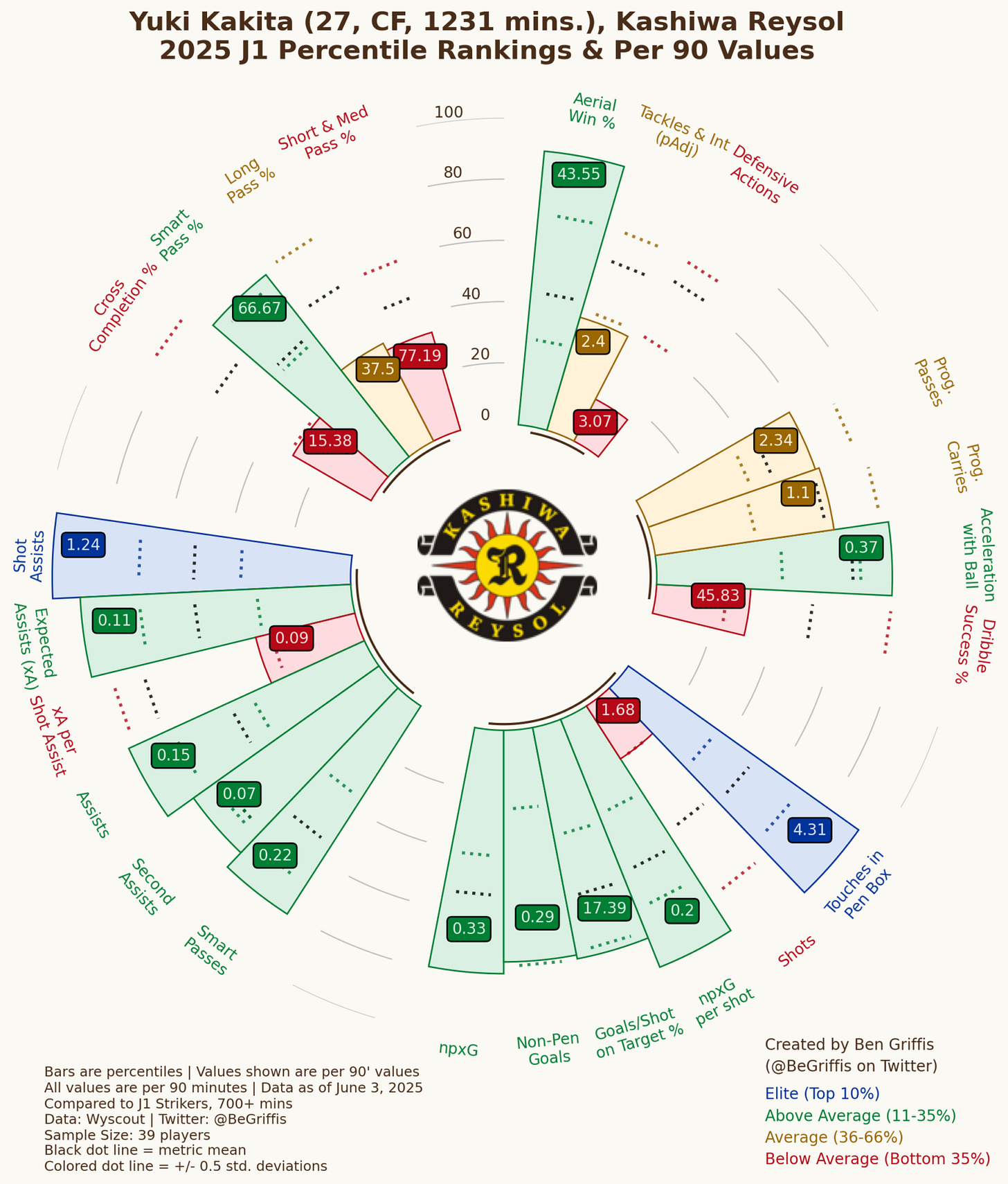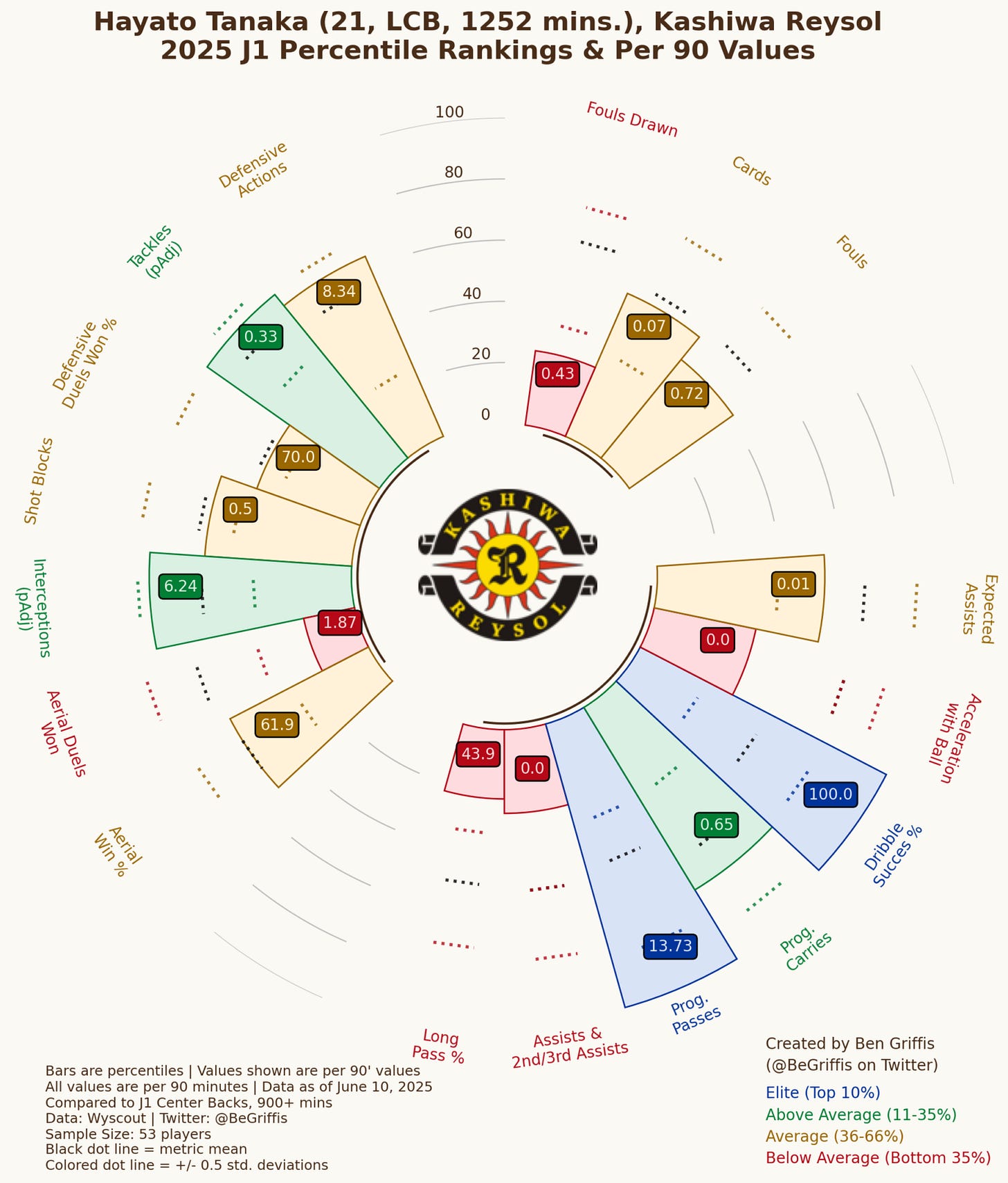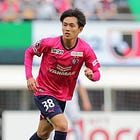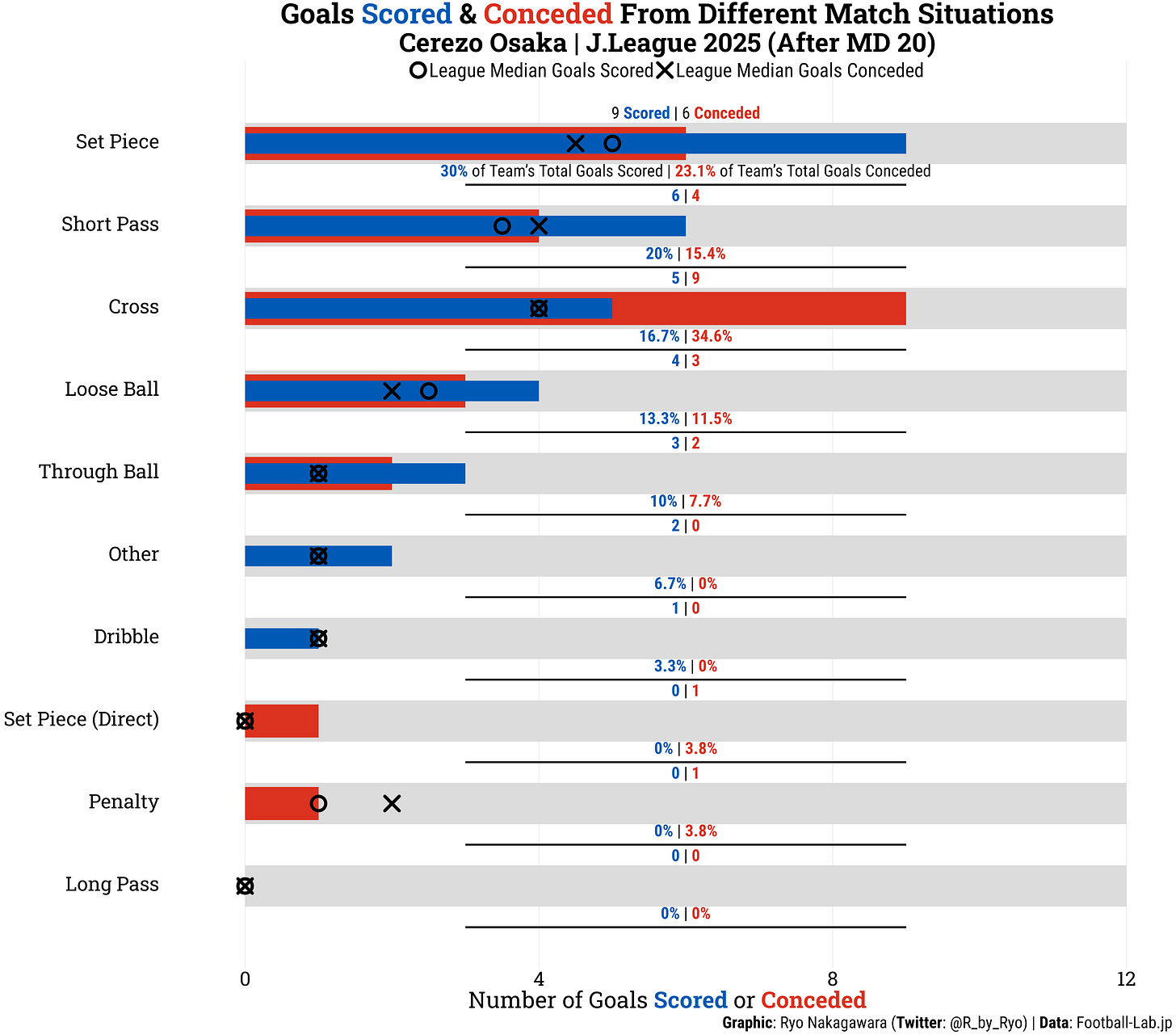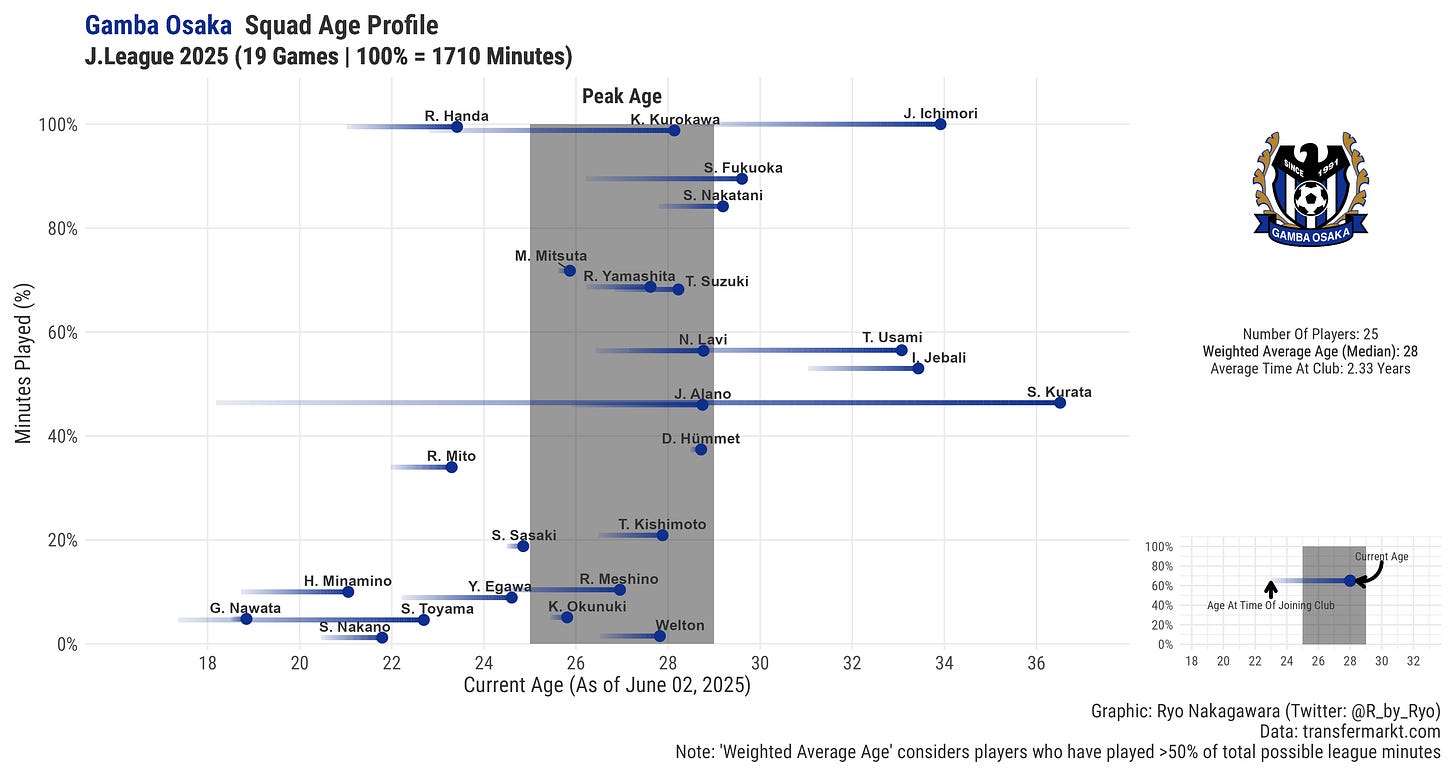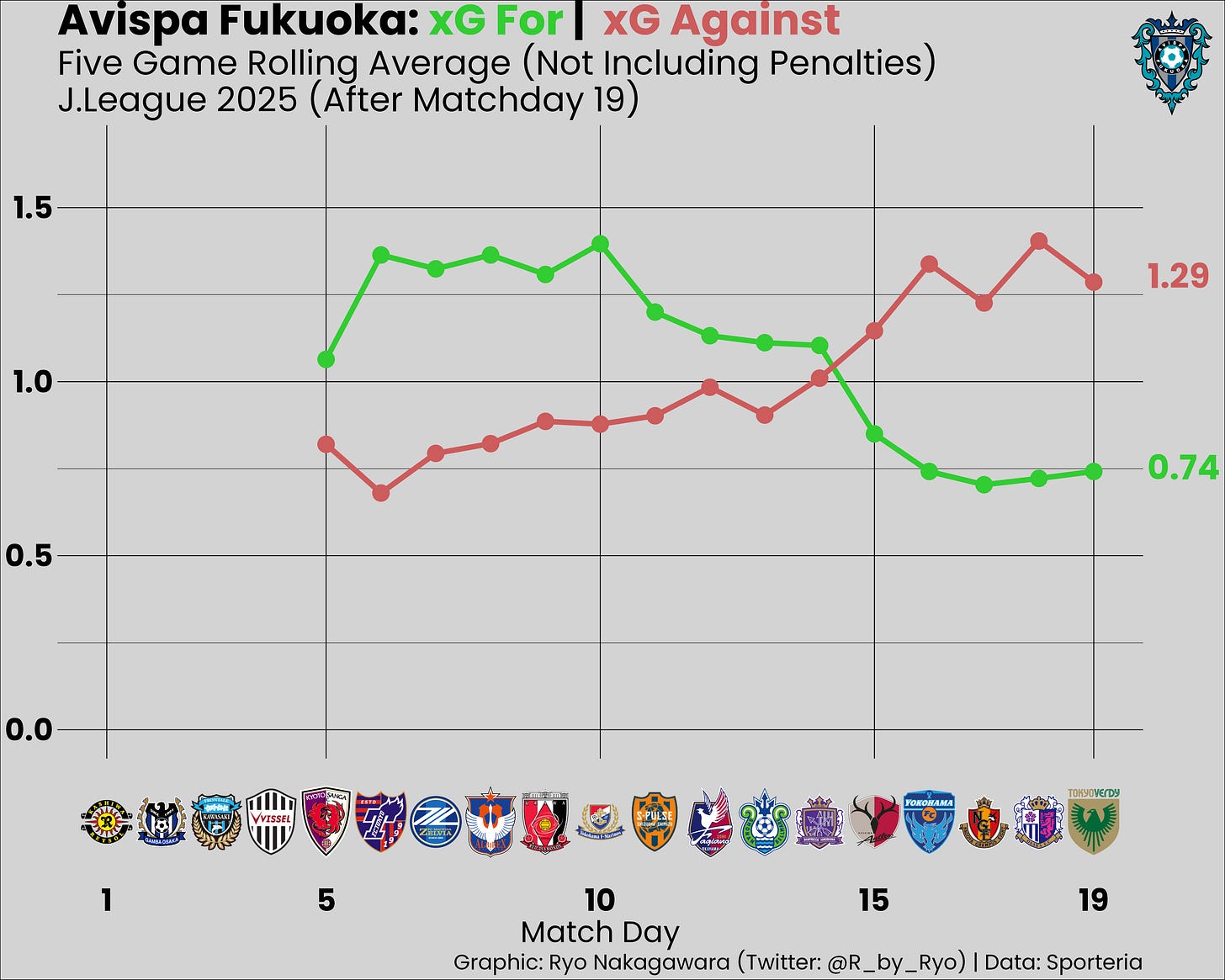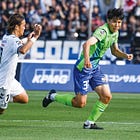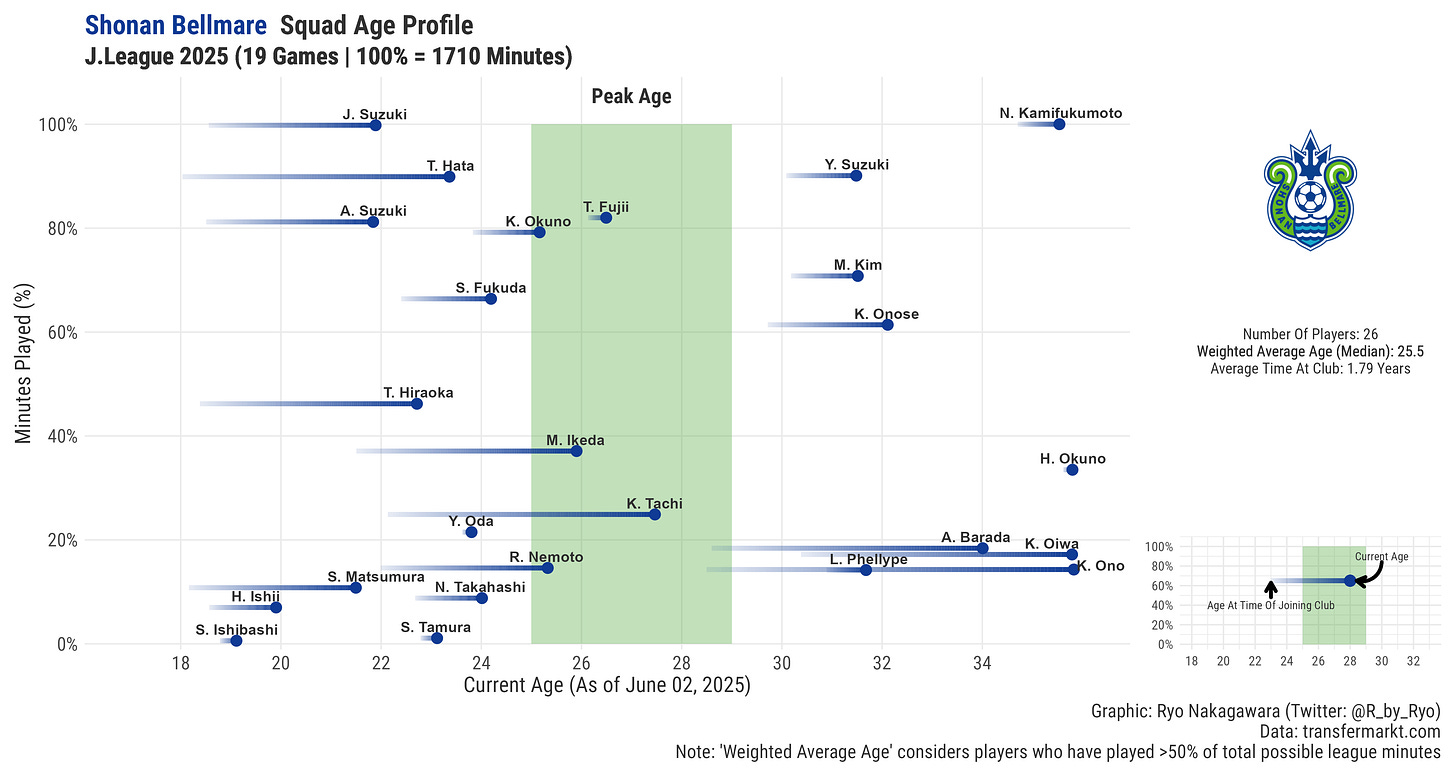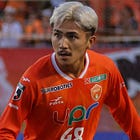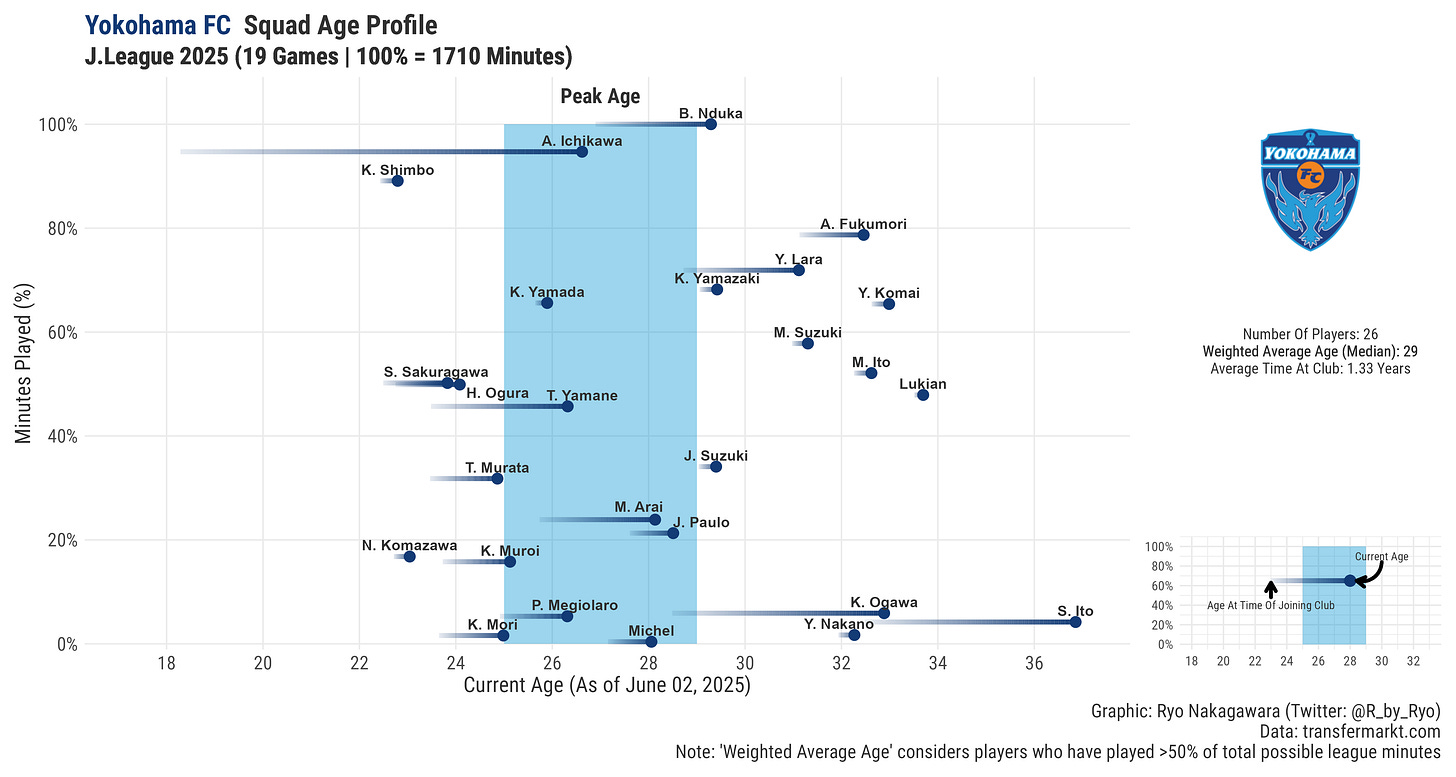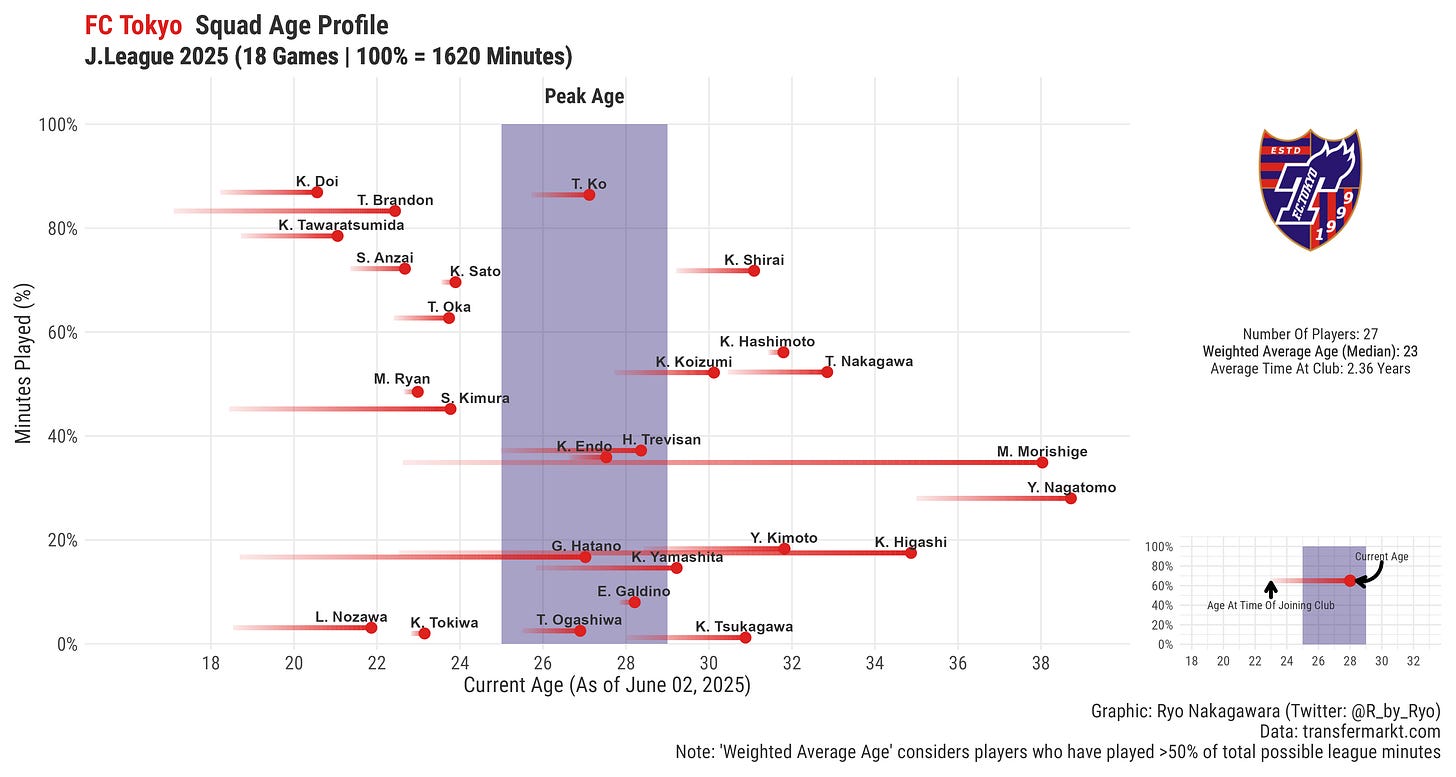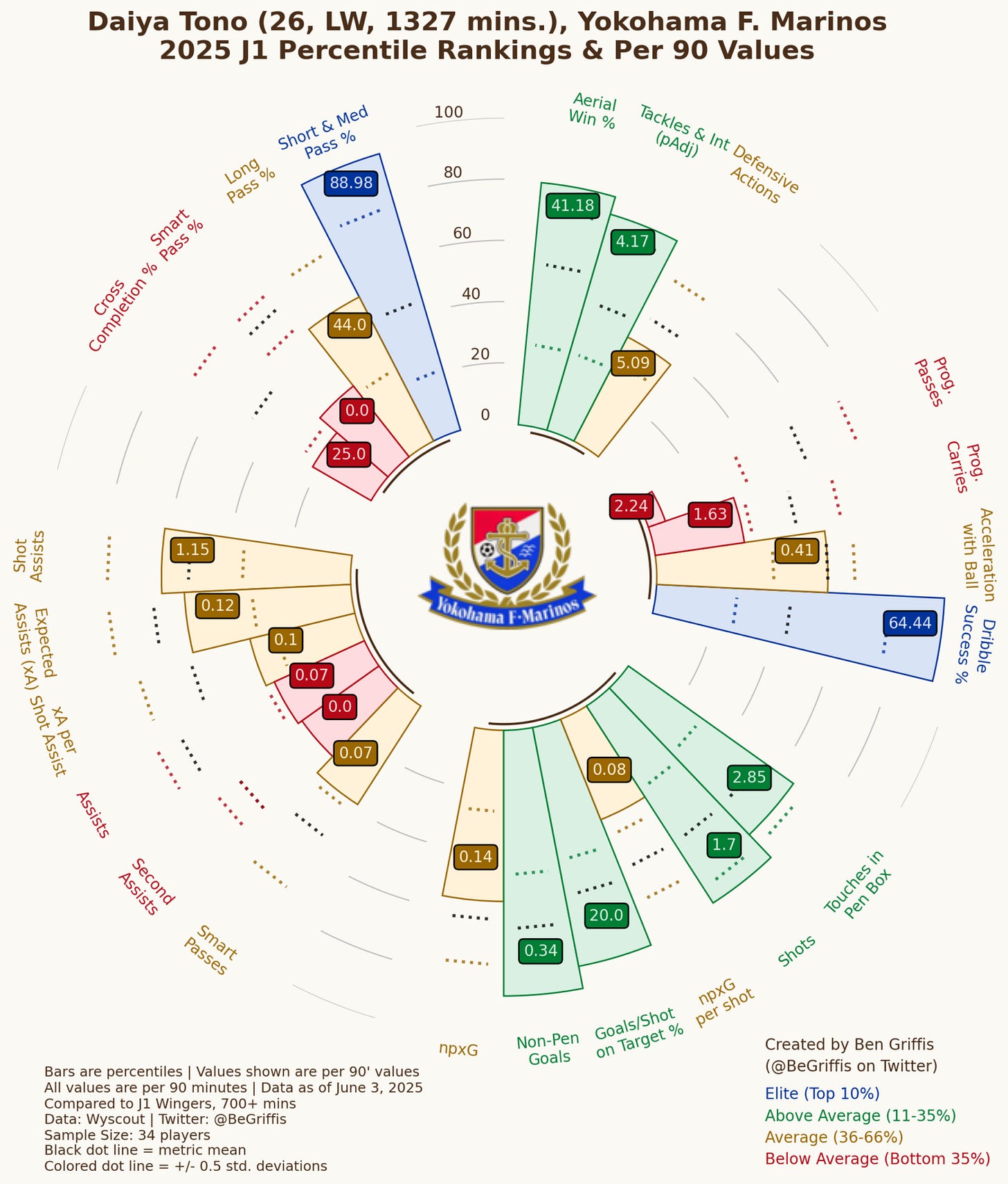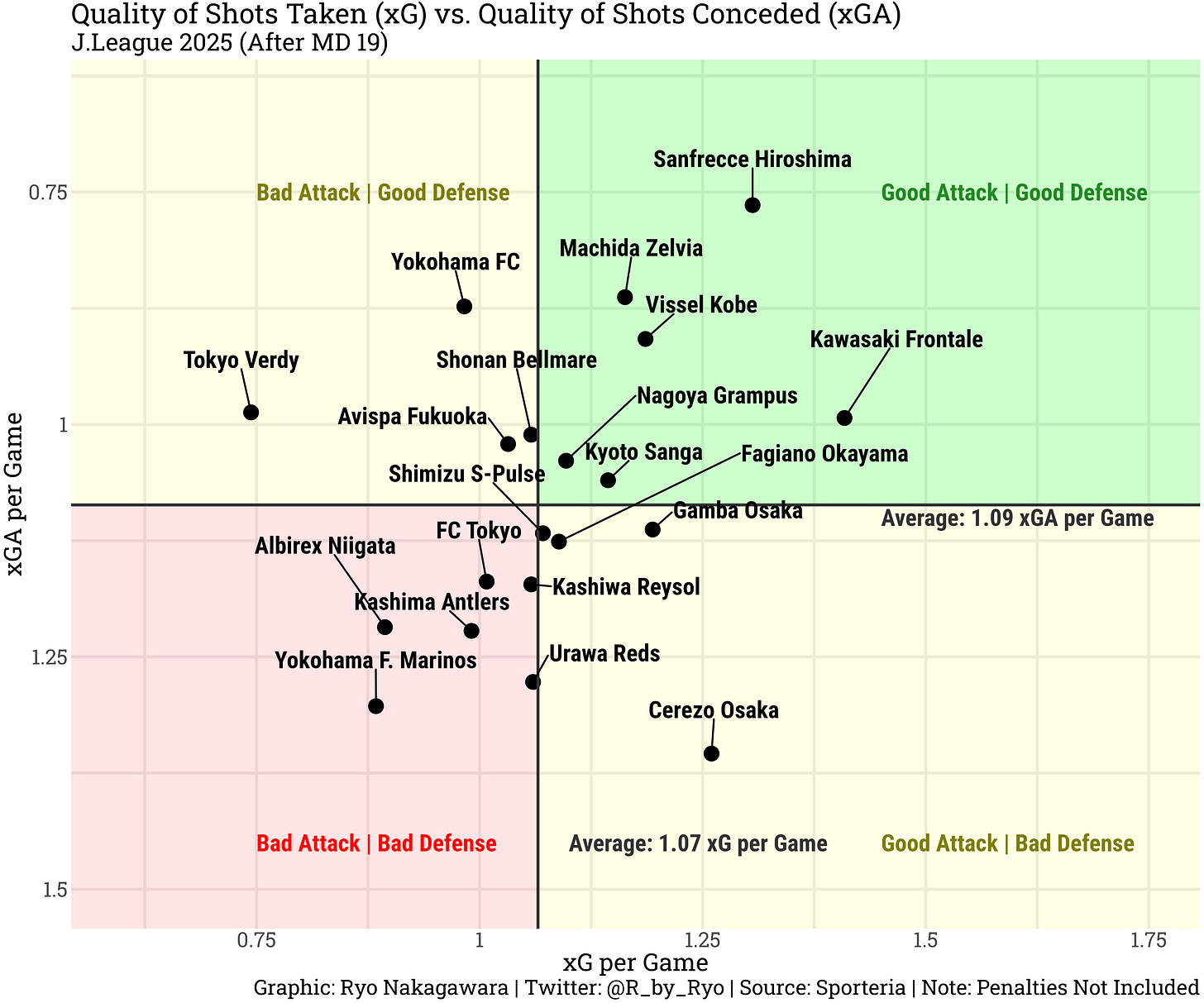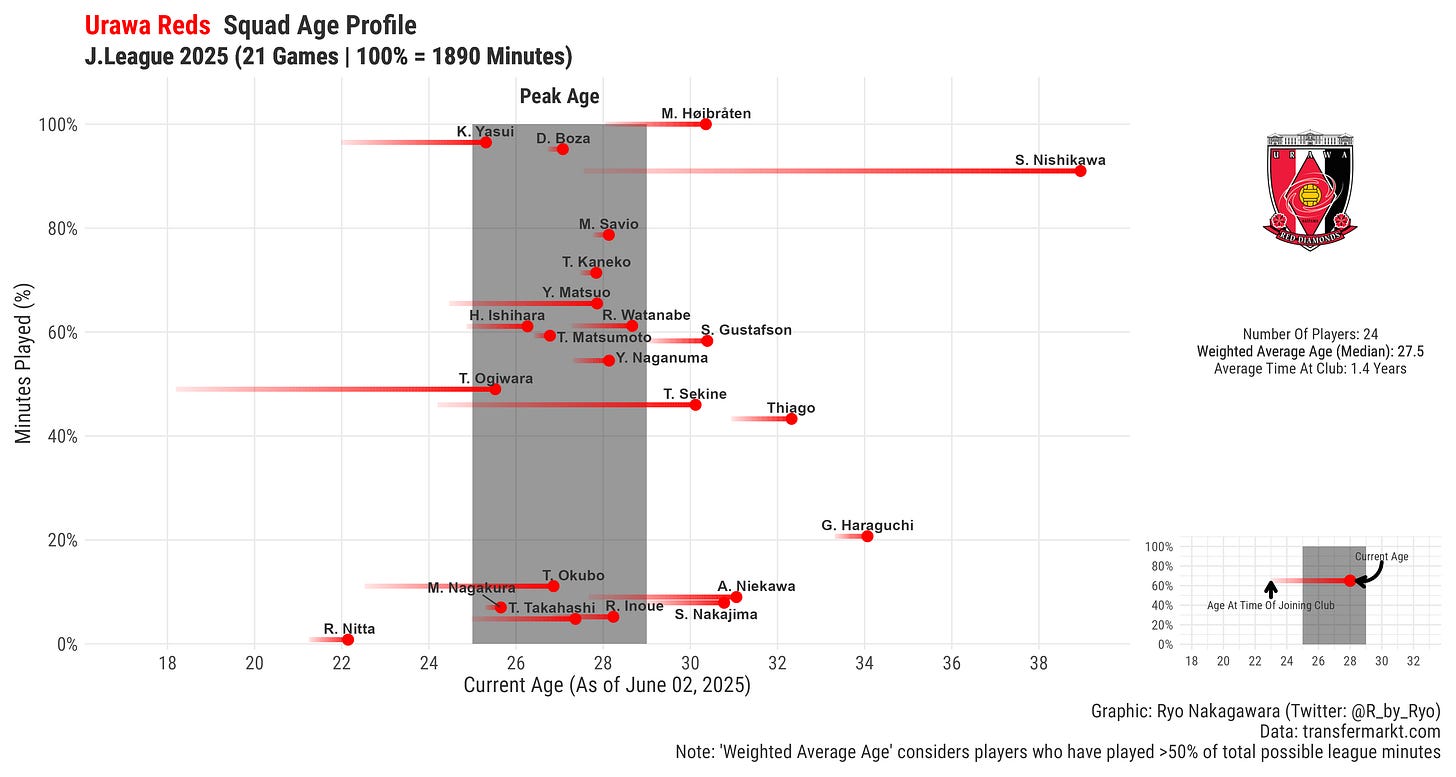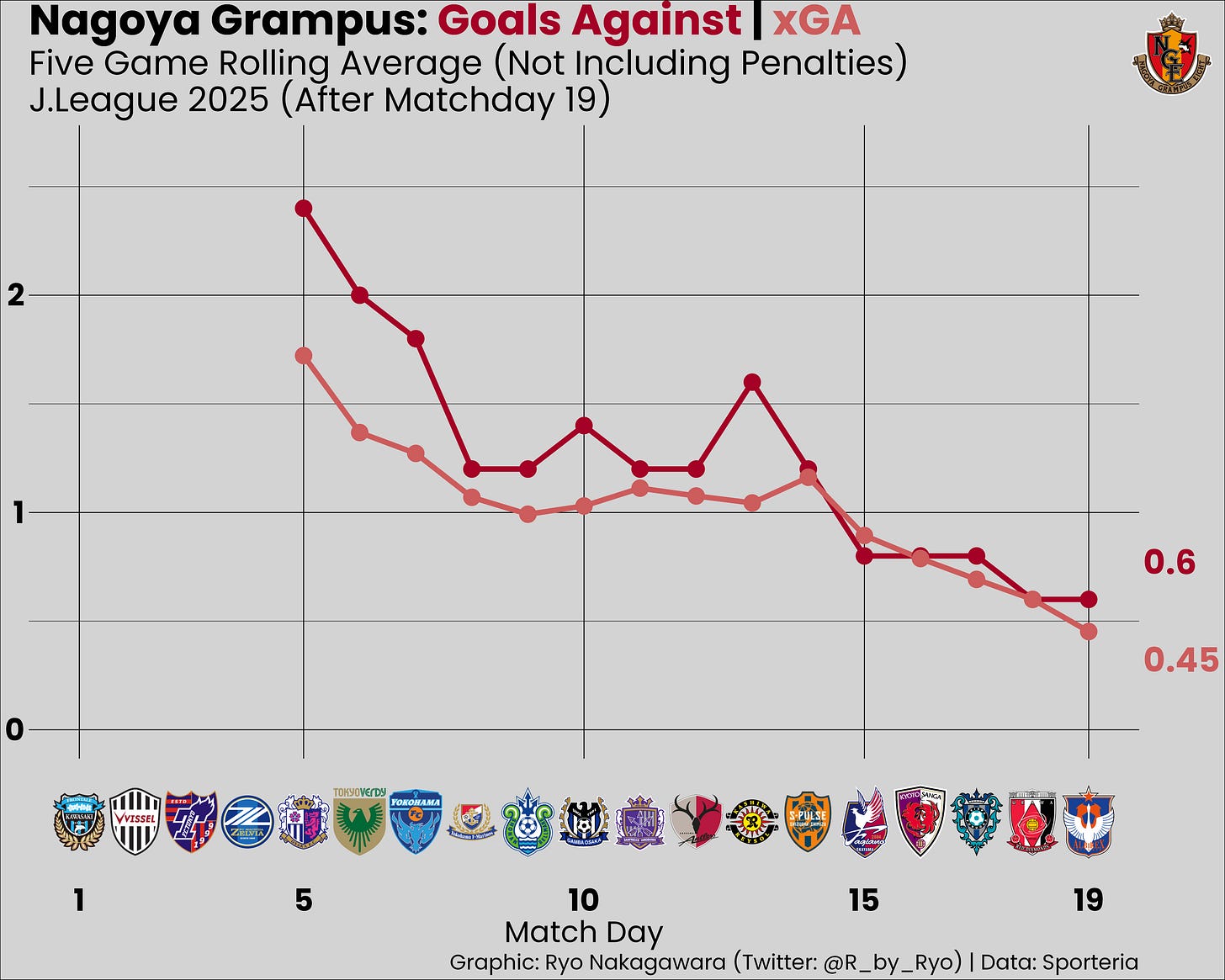J.League (J1) 2025 Mid-Season Review
Lots of surprises at both ends of the table!
Hello again, it’s that time of the year for the J.League Season Review! For those unfamiliar, I take a detailed look at each and every team with both data and my eyes. Thanks to all of your support in the past few years, this newsletter surpassed the 1,000 subscriber count around a month ago! It’s now read not just by regular fans but also club analysts/scouts, agents, consultancies, and other industry experts from across the world so I’m really happy about reaching this milestone, so again thank you! These reviews have a bit more casual, fun tone compared to my scouting reports. Hope you enjoy!
This review consists of:
The league table
A section on every J1 team: Summary overview, tactics, data, players, etc.
A section on the different types of data viz: Explanations and link to the viz for every team
Some notes, warnings, disclaimers, etc.:
All the data stuff is done with R.
All the tactical stuff is created using Tacticalista.
To keep up to date with all of what’s happening in J1, I made a giant Twitter thread of lots of cool informed people to follow on Twitter for English language/international J.League content. You can find it here!
All of the shots and xG related stuff you see in the viz are non-penalty stats. Exceptions are stuff like the time interval and scoring situations plots. When I mentioned these stats in writing I usually mean non-penalty at the team level but I explicitly write it out at times just to be super clear.
My views come from watching only J1 league matches. The things I talk about here are primarily based on the J1 league with occasional references to cup competitions.
Due to the Asian Champions League and Urawa Reds’ participation in the Club World Cup, the schedule and the number of matches played by everybody is all out of whack (even more so than usual). Not a whole lot I can do about that so keep in mind about that discrepancy when I talk about the stats…
Data sources: Transfermarkt, Sporteria, Football-Lab, FBref
Once again, this has taken up a gargantuan amount of time for me to watch/read/code/compile/organize so please like and share it across all of your social media, your IRL (in-real-life) friends, your family, your dog, etc.
Let’s get started!
League Table
If you’ve been watching the J.League for a number of seasons, you’ll realize that a lot of the times the results, the data, and the table just don’t really make sense. Chaos Energy J.League is all just vibes, man.
Kyoto Sanga are in 2nd to the surprise of everyone (including Sanga supporters), Sanfrecce continue to be profligate in front of goal that has cost them points over the past few seasons, Grampus have recently got themselves out of the relegation zone, etc. More detail on each team in the following sections!
Kashima Antlers (1st, 40 Points)
13 Wins // 1 Draws // 5 Losses
Location // Stadium: Kashima // Kashima Soccer Stadium
Manager: Tohru Oniki
29 Goals (4th); 15 Conceded (2nd)
18.83 non-penalty xG (15th); 23.21 non-penalty xGA (17th)
Top goal scorer: Leo Ceara (10 goals plus 1 penalty)
Goalkeeper: Tomoki Hayakawa
Tohru Oniki's revolution at Kashima has turned into less a revolution and more of tweaks to the tried-and-tested Antlers formula. After various bumps and bruises in April, Kashima Antlers have really pulled ahead of the packed table to gain a comfortable lead at the top. Of course, I wrote that previous sentence and then Antlers lost to bottom-placed Marinos to cut their lead at the top...!
They have shown a remarkable toughness and ability to come back from behind on top of the fact that Tohru Oniki has employed a very much an all-or-nothing approach which has resulted in just single drawn game so far this season. This mentality has them at the top of the table which really reinforces the adage that “draws kill title charges” and it's simply better to go all out for the 3 points! Overall though, they haven’t quite been as dominant as you expect them to be…



With Ikuma Sekigawa's long injury absence, Kashima's Center Back depth has come into question again (it’s been a running theme at Antlers for the past few seasons…) so I imagine there will be some new signings here even after the winter purchase of Kim Tae-Hyeon. 16 year old Anthony Motosuna was also registered from the youth teams so he might be given a chance too, or at least participate in first team training. NOTE: Earlier this week, Antlers signed veteran Kaito Chida from Tokyo Verdy.
Tomoki Hayakawa has continued his good form in goal and Antlers fans are growing louder and louder in their shouts for him to be called up to the national team squad. I think he's a very good shot stopper this season (at the J1 level at least) but his lack of being more proactive off his line and adding value in the build-up probably limits his upside at the international stage. To be clear, this can also be related to team style (compare how Kashima build-up compared to Cerezo Osaka, for example) rather than any lack of ability on Hayakawa’s part. Given how open the Goalkeeper situation is after Zion Suzuki, it wouldn’t hurt to try him out though.
Otherwise in defense or at least out-of-possession I have concerns. While Antlers don’t really press from up high especially with questions over who is the best player to pair up with Leo Ceara, I don’t find their middle block to be that effective either… There’s issues where the very aggressive Center Midfielders get pulled away from the middle of the pitch and teams are able to switch across quickly to put Kashima Back 4 on the back-foot.

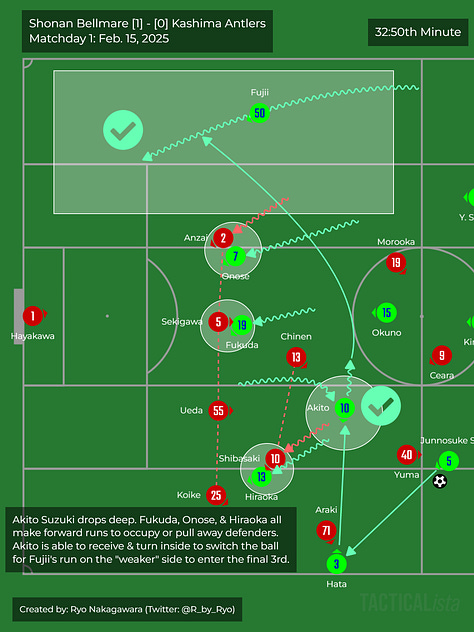
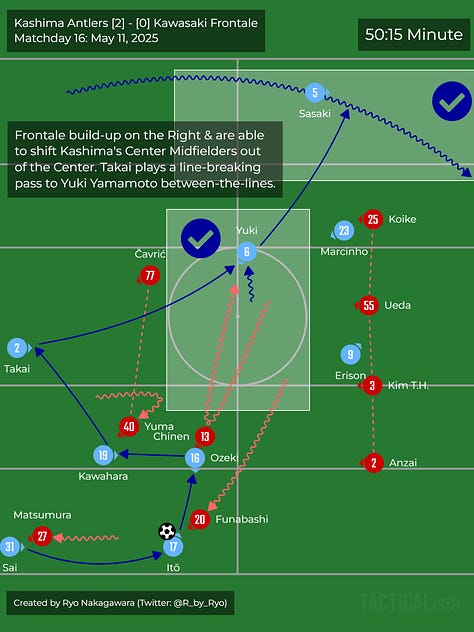
New season, new manager but Antlers are still very much Yuma Suzuki-centric for ball progression. Dropping deep or settling long balls, the talismanic striker continues to be the fulcrum of this team. Koki Anzai has been excellent down the Left as the beneficiary of Yuma Suzuki’s tendency to drift to the Left. Their partnership in the past few seasons (check out my previous reviews) have been extremely fruitful for Antlers and Tohru Oniki has simply let that continue. Don't fix what's not broken! (NOTE: Well… Koki Anzai is now out with a long term injury so there’s definitely going to be changes needed here!)

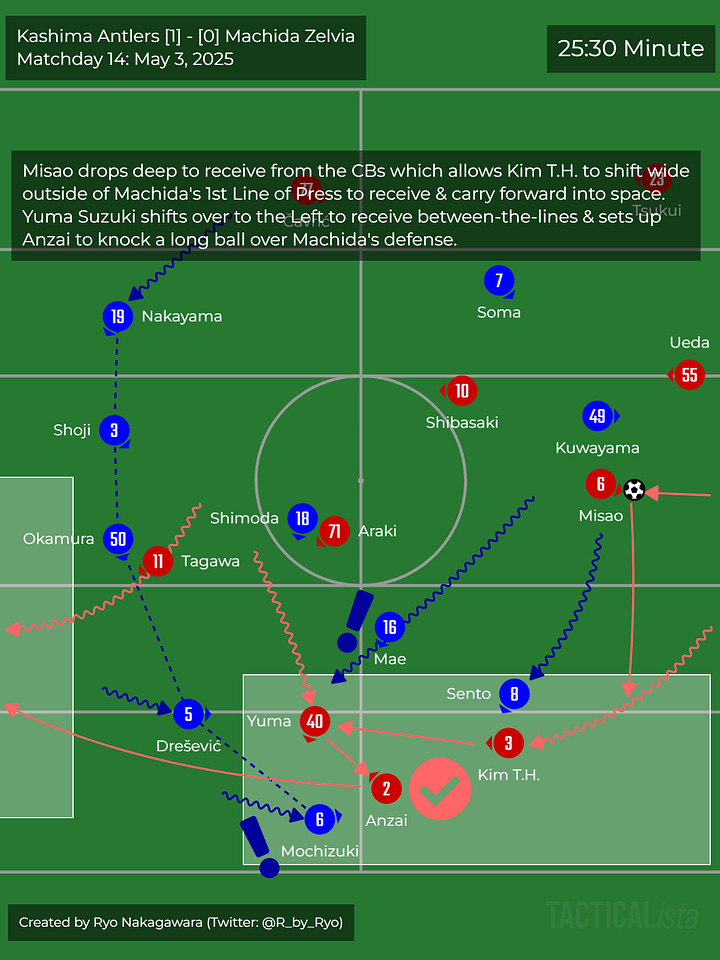


To the surprise of most people, 22 year old Yu Funabashi has fought off more experienced competition to win a spot in the starting XI in the double pivot over the last month or two. Good progressive passer and defensive work, added bonus of getting some (not a lot) of shots too.
Leo Ceara has continued his clinical finishing in front of goal following his arrival from Cerezo Osaka, his 11 goals coming from just 5.6 xG (penalties included)! His uncanny ability to strike the ball really well, even from difficult positions, is a big factor in why Kashima Antlers are so high up the table despite their middling overall underlying xG numbers.
Despite the attacking talent and the presence of Tohru Oniki, Antlers surprisingly don’t get into the final 3rd nor into the box very often. They rank 15th in both metrics! Despite this, they have a habit of making their chances count and really get shots on target. This is on top of the fact that they’ve won and converted 4 penalties which has been a not insignificant proportion of their goal haul so far.
Given the Huge (capital H) discrepancy between their expected vs. actual numbers, I’m really skeptical of Antlers being able to keep going… however, the reality is that nevertheless they do have 40 points on board already, 6 whole points ahead of 2nd place Kyoto Sanga who have played a game more! From the games we’ve seen it’s clear that Kashima Antlers aren’t infallible, especially now that they’ve lost Ikuma Sekigawa and Koki Anzai in defense. It’s a very un-Oniki like style of football but it does show how he’s willing to adapt to new environments to get the best out of his current team, even if a lot of the results are coming from really good finishing and then being able to squeak by…
Kyoto Sanga (2nd, 34 Points)
10 Wins // 4 Draws // 6 Losses
Location // Stadium: Kyoto // Sanga Stadium
Manager: Cho Kwi-jae
30 Goals (tied 1st); 22 Conceded (11th)
22.87 xG (4th); 21.20 xGA (12th)
Top goal scorer: Rafael Elias (7 goals plus 1 penalty)
Goalkeeper: Gakuji Ota
One of the biggest surprises of the season so far. Yes, that’s right. Kyoto Sanga are in the unheard heights of 2nd place! To me, they are still maintaining their physical, high octane pressing and line-breaking runs play-style we're all accustomed to. However, I believe they have made improvements in possession. They are not so overly reliant on quick transitions (although, of course it is still a potent weapon in their arsenal). Kyoto have been passing and combining a lot more with close distances and relationships between their players in possession. Although to be clear, it’s not like they’ve turned into a silky smooth passing outfit. It’s more that they combine really well in small spaces.
The key players are similar to last season with Rafael Elias on an absolute tear with 8 goals (from 5.39 xG) and 4 assists so far. I thought he might cool down from his xG over-performance last season but he’s simply decided to continue to defy the underlying numbers! Taichi Hara has had excellent displays, with equal parts aerial and technical prowess that has led to 2 goals and 5 assists. Meanwhile a "new" player in the form of Masaya Okugawa (returning to his childhood club) has added a new dimension in attack with his quality experience and goal scoring instincts.
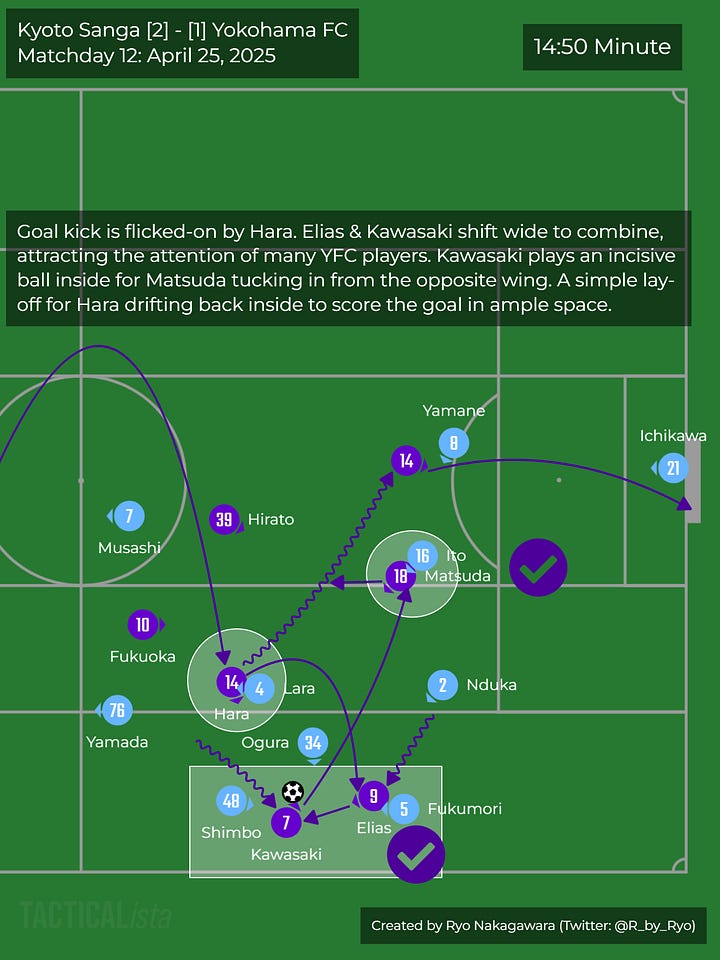
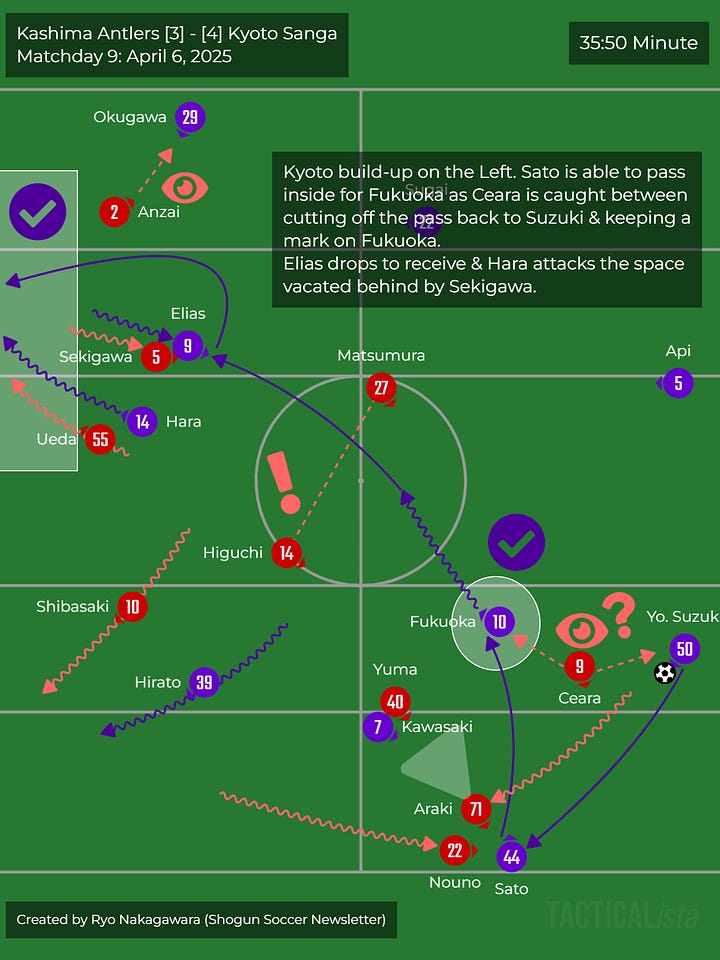
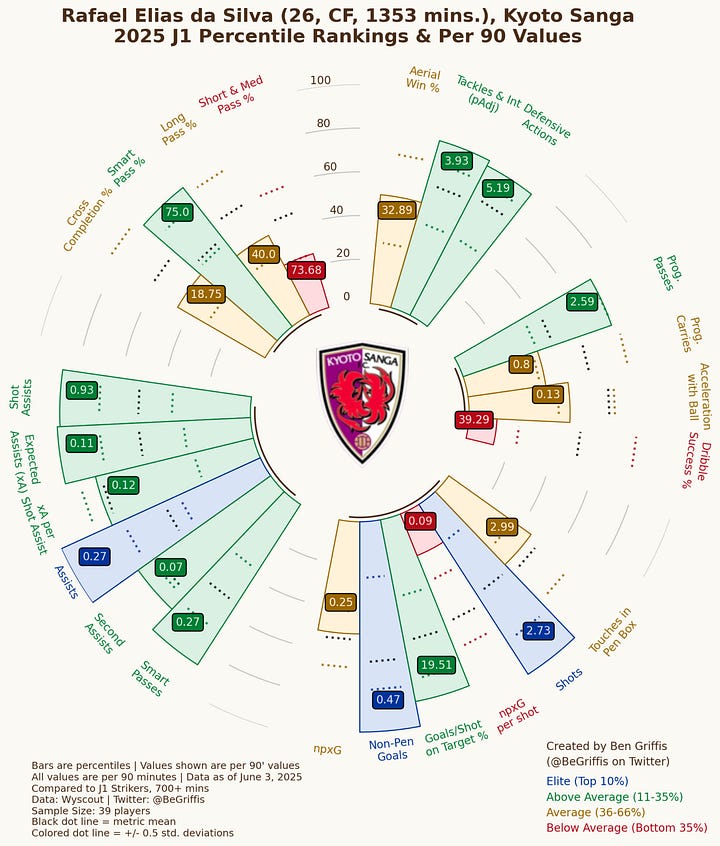

Sota Kawasaki has been providing huge value by supporting teammates in possession through his passing and off-the-ball running. It’s been interesting to see him evolve from a deep lying midfielder, mostly involved in ball-winning, to become much more of a box-to-box player in the past few years. His stats don’t really “pop” but he’s interesting nonetheless.


Nevertheless, for all this positivity... the underlying numbers don’t paint quite a rosy picture. Their defense actually hasn’t materially improved compared to last season, they are simply just not conceding goals due to a variety of factors including Gakuji Ota in the form of his life between the sticks. Set piece defending continues to be quite poor (over 30% of their goals conceded), all of which gives me doubts on Kyoto continuing this form to last the season. Their high-pressing style is really good at winning the ball, however if that is broken through Kyoto are quite vulnerable in a middle and low block with their backs against the wall. Interestingly though, they are fairly decent at suppressing the quality of shots even if they allow quite a lot.
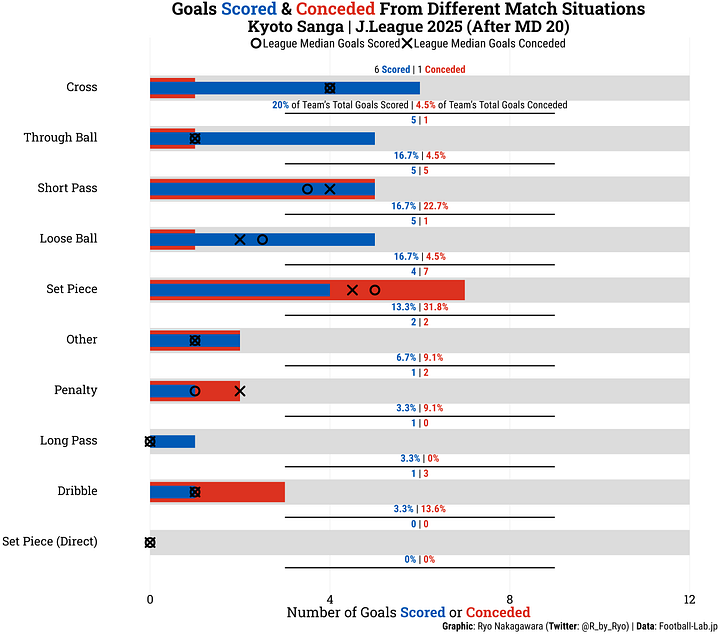

Of course, they have already put enough points on the board so they won’t be in their usual relegation fight (most likely) which is a huge plus for them. A lot relies on the fitness & form of Rafael Elias and Taichi Hara though.
Urawa Reds (3rd, 34 points)
9 Wins // 7 Draws // 5 Losses
Location // Stadium: Urawa // Saitama Stadium
Manager: Maciej Skorża
26 Goals (5th); 20 Conceded (10th)
22.26 xG (6th); 26.81 xGA (19th)
Top goal scorer: Ryoma Watanabe (6 goals)
Goalkeeper: Shusaku Nishikawa
It was another busy off-season for Urawa with Maciej Skorża having come back to the club in the summer of 2024 and the upcoming Club World Cup participation precipitating the need for a big overhaul in the squad. The biggest headline transfer was that of Matheus Savio from neighbors Kashiwa Reysol. While the start of the season has been quite slow, in recent months Urawa Reds seem to have got sorted out their some of early issues.
When I was watching their first batch of games in February/March I was rather confused by Urawa turning into a Back 3 in the build-up to no discernible positive effect. In the beginning of the season I felt that Yusuke Matsuo's individual brilliance at driving forward with the ball was covering up for a lot of their ball progression issues. Things started improving more when the double pivot stopped dropping deep, trusted the CBs & Nishikawa to build-up by themselves. This resulted in the midfielders staying further forward and able to create passing options for their fellow defenders in the mid-3rd. The knock-on effect of forcing opponents to not be able to push too many players forward in pressing Urawa's back-line, all of which resulted in a lot more calm in Urawa's build-up, more time for Center Backs and Nishikawa to receive and pass facing forward under less immediate pressure.
Danilo Boza has been a big positive for the Reds back-line, not in the least because he has made Marius Hoibraten look far better compared to last season. He isn’t the most active defender but intervenes at crucial points. In possession Boza has also been a positive by being comfortable holding and carrying the ball forward in the build-up phase. While overall Urawa’s defensive problems are worrying, I don’t think Boza is at fault most of the time.
In midfield there is a lot of talent. Of course, Matheus Savio took a bit of time to get used to being part of the team but is a reliable danger, integral to Urawa’s attack now.
Ryoma Watanabe has been very busy attempting to play every role in midfield and maybe trying to do a bit too much of everything at times. He's looked better in recent weeks being able to just focusing on things further forward instead! In terms of a supporting role, Kaito Yasui has been good this season as a "jack-of-all-trades" type. He makes a lot of runs from midfield to support the attackers as a passing option. There are still questions about him from a defensive standpoint but the more I watched Urawa this season it seems to be more of a structural issue… but more on that later.


Further forward alongside the aforementioned Yusuke Matsuo, Takuro Kaneko has been a good outlet on the wing as well. Urawa Reds transition forward really well given the power and trickery of the wide attackers they have.
A big issue at Urawa Reds in the past few years has been the lack of a clear "15~20 goal" striker but if everybody continues to chip in from every position it may not be a huge issue. Ryoma Watanabe leads the team with 6 goals while there are quite a few other players on 3 goals. The next attempt at filling the hole up top was announced recently. It’s Hiiro Komori, formerly of JEF United and coming back to Japan after a disappointing spell in Belgium. What I wrote about him back in December should still apply now. His biggest weakness is his lack of physicality, a big factor in his failure in Belgium. Given how Urawa usually wants strikers to be physical/hold the ball up (at times unintentionally so…), I do have some concerns regarding how he would fit here.
On top of the issues up top, the underlying chance-creation numbers aren’t actually all that amazing, certainly not bad though to be clear. Urawa have been able to get by through the sheer quality shot-striking from their best skilled players but things will need to improve further if they don’t want to keep relying on their players “running hot” in front of goal…
The big issue is the defense. Their pressing isn’t great while then shifting back into more of a mid-block has also had its issues.


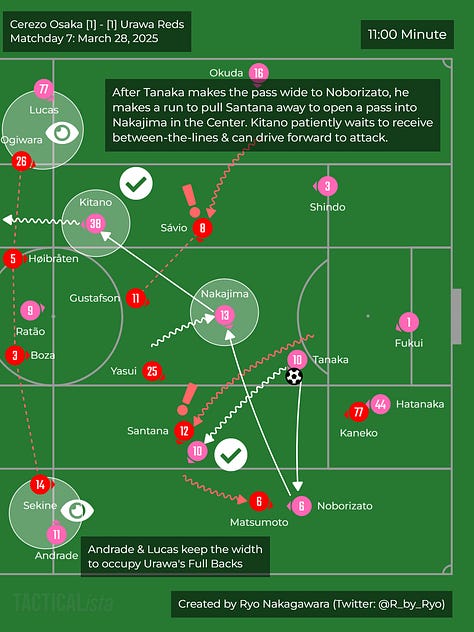
Set-piece & dealing with crosses in particular have been very poor (30 and 25% respectively!). Not to mention they have the 2nd worst xGA and 2nd most shots conceded using Sporteria’s numbers after subtracting penalties… They’ve been lucky to get away with only conceding 20 goals from 26.81 xGA especially since Shusaku Nishikawa isn’t actually saving more goals compared to xGOT faced (according to FotMob’s goals prevented numbers).
In general, Urawa look far better when they’ve defend deep and counter but that’s not really the way that Urawa want to play, in that they aren’t being effective by design, more just by happenstance and the quality of their players in attacking transitions. Still given their good results and their place in the table Urawa can continue to work on their possession and defensive issues without having to panic anymore. With a win against Yokohama FC in June, Urawa Reds go into the Club World Cup with some confidence sitting 3rd in the table, especially compared to the darkness of last season.
Kashiwa Reysol (4th, 34 Points)
9 Wins // 7 Draws // 3 Losses
Location // Stadium: Kashiwa // Sankyo Frontier Kashiwa Stadium, “Hitachidai”
Manager: Ricardo Rodriguez
22 Goals (10th); 17 Conceded (4th)
20.11 xG (12th); 22.27 xGA (16th)
Top goal scorer: Yuki Kakita & Mao Hosoya (4 goals)
Goalkeeper: Ryosuke Kojima
Kashiwa Reysol underwent wholesale changes during the off-season as they resolved to escape from bottom-half mediocrity and the wayward direction the club had taken in the past few seasons. In came Ricardo Rodriguez, who has had experience managing in the J.League with Tokushima Vortis and Urawa Reds, which signaled a tactical shift from a defend-and-counter to a more possession-based team. So far the results have been... very good! The team sit in 4th! The underlying data gives a very different perspective though.



Koki Kumasaka is a 24 year old Center Midfielder that rejoined Reysol in 2024 but didn't make many appearances. With the arrival of Rodriguez, his career has taken a positive turn. Kumasaka is a pivot (double or lone) that excels in supporting teammates as a pass receiver, especially in the build-up phase. On top of his technical proficiency he uses his mobility and size to contribute defensively as well. His performances this season has earned him a call-up to the Japan National Team. There are still areas to improve but he is an interesting prospect and I hope to write about him before the season is over so be on the look out for that. NOTE: During the June window Koki Kumasaka got an ACL injury while training with the national team…


As a team, Reysol are very honed in on making runs into the half-spaces and creating chances via cut-backs. Indeed, they’ve created a whopping 35% of their goals from crossing situations according to Football-Lab. Do note that this includes all crosses, not just cut-backs but more to the general point that they create a lot of chances in this fashion (they could've had at least 3~4 more cut-back assists vs. Marinos for instance). Wataru Harada is probably the most underrated player on this team given his lack of name recognition and quiet but effective role in the team. He is technically proficient, takes up good positions in the half-space, and is a great ball progressor through passing/carrying!
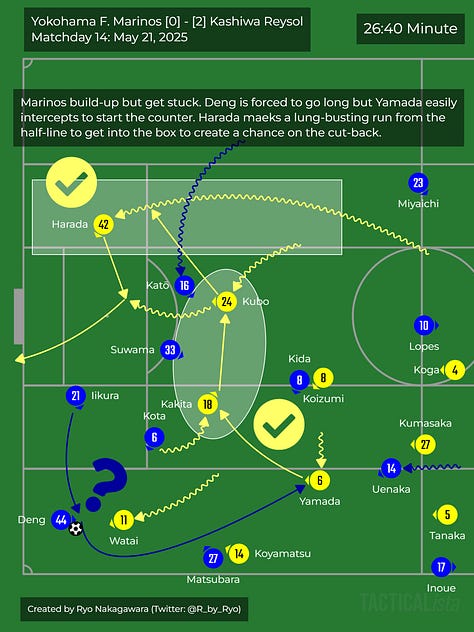


The Wing Backs, normally Tomoya Koyamatsu on the Left and Tojiro Kubo on the Right are very important for this style of play. Tojiro Kubo looked good at Fujieda in J2 a few seasons ago but things didn't quite work out at Grampus. He’s a good dribbler/ball-carrier that’s finally getting the regular chances at the J1 level that he deserves.
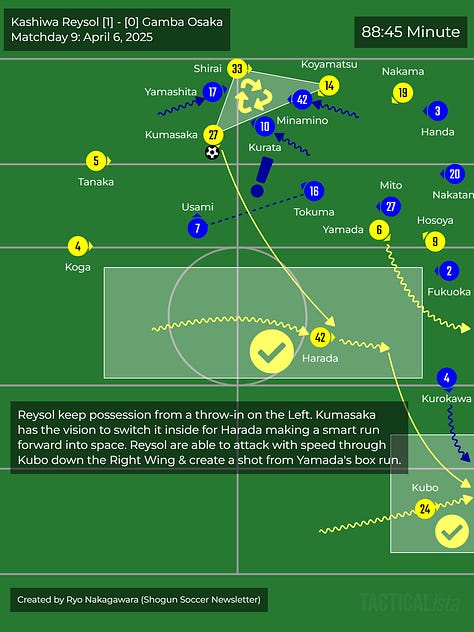

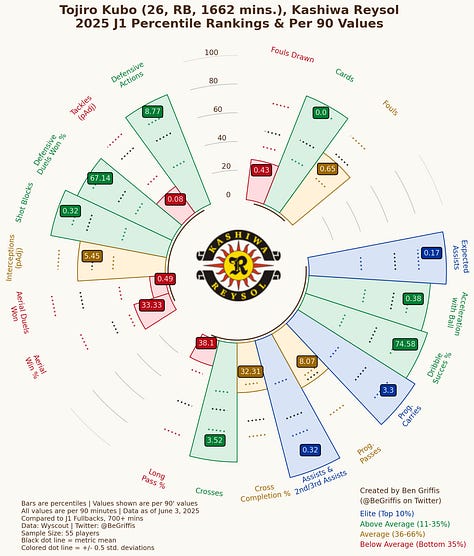
Overall, Reysol ranked quite high in terms of average entries into the final 3rd and the penalty area (1st and 2nd in the league respectively), along with top-of-the-league high possession rate (58.8%) averaged across their matches. They are a team that love to dominate and suffocate teams with their skill in-possession.
Of course, for all the plaudits I still think there are issues... In sharp contrast to the previous points, Reysol do not get shots off (nor on target) as much as you might think with this dominance as they rank below mid-table in both metrics (14th and 11th respectively).
Up front Yuki Kakita has honestly played well, very physical as always and providing a platform up top with 4 goals and 4 assists so far this season. However, Reysol are still trying to find the best balance for the Front 3. On one hand you have Masaki Watai & Yoshio Koizumi for their passing, positional sense, and creativity. On the other there’s Kosuke Kinoshita (well not anymore with his transfer to Sanfrecce…) and Mao Hosoya for more directness, physicality, and goal scoring.
There is also an element of stubbornness in the game plan. They don’t seem to make a lot of adjustments when bumping up against hardened defenses over-and-over again. It's clear that Reysol do have a problem creating quality chances and finishing them. As a result, title rivals Kashima have lost 2 whole games more than Reysol and yet are 6 points above them in the table. Reysol need more goals to turn those pesky draws into wins.
At the other end of the pitch, Reysol are fairly strong defensively by being very good at preventing good quality shots, they are happy to let their opponents take poor quality shots. Taiyo Koga has been a real leader at the back as the captain while Hayato Tanaka has made the step up to J1 quite seamlessly after a very good J2 season on loan at V-Varen Nagasaki last year. Tanaka’s progressive passing ability has been a perfect fit for Rodriguez’s style of play. While occasionally there have been issues with their pressing, Rodriguez and the players have made some good adjustments during games to be able to win the ball back and create short counter opportunities.
The Rodriguez Reysol Revolution has made a sterling start. Despite the not-great underlying numbers when you watch this team play compared to last season, the difference is night-and-day! Given their position for a title charge, the front office has put out all stops to support the Spanish manager. In recent weeks Reysol have brought in Yota Komi (Albirex Niigata), Yusuke Segawa (ex-Reysol but was at Kawasaki Frontale), and Seiya Baba (Consadole Sapporo) to reinforce the squad. Only time will tell if they become difference makers by December!
Sanfrecce Hiroshima (5th, 32 Points)
10 Wins // 2 Draws // 6 Losses
Location // Stadium: Hiroshima // Edion Peace Wing Stadium
Manager: Michael Skibbe
20 Goals (12th); 14 Conceded (1st)
23.5 xG (3rd); 13.75 xGA (1st)
Top goal scorer: Ryo Germain (1 goal plus 3 penalties)
Goalkeeper: Keisuke Osako
It's been a hectic season so far for Sanfrecce Hiroshima with their off-field issues like Valere Germain's eligibility resulting in a forfeit of their ACL2 QF 1st Leg, along with big injuries to Tolgay Arslan and later Yotaro Nakajima hampering their clinical finishing & creativity. More bad news was to come as midfield linchpin Satoshi Tanaka also got injured in May. Despite all that it’s quite telling how little Shion Inoue has played with Skibbe preferring to shift Shunki Higashi inside from Wing Back to partner Hayao Kawabe instead.
Sanfrecce continue to be an assertive team under Michael Skibbe, pushing into the final 3rd and entering the box quite often (3rd and 4th in the league respectively). The biggest issue to focus on with this team is one that I’ve discussed all throughout Skibbe’s tenure: not converting chances into goals.
Sure, they have the highest xG but when you consider that all these years, the plan has been to take hundreds of shots… but poor quality ones mainly created via crosses (most per game in the league), it's no surprise that their xG per Shot is fairly low and their finishing from those chances have also been low. To put it simply, it’s quite telling that they are 3rd in shots taken… yet 14th in shots on target and 13th in goals scored! The fact that more than 50% of Sanfrecce’s goals have NOT come from open-play says it all really: 3 penalties (15%) and 8 set-piece goals (40%)!
Ryo Germain has been struggling for non-penalty goals, with just a single one from open-play despite racking up 5.5 non-penalty xG (it’s 4 from 7.9 if you include all 3 of his penalties)! His erstwhile partner-in-crime in attack, Mutsuki Kato has been suffering a similar malady scoring only 1 from 2.86 xG. Like I said last season, both do plenty of stuff outside of goal scoring but nevertheless it can be quite frustrating to watch.




While Naoki Maeda arrived based on Arslan's injury, it's really been Sota Nakamura who has filled in the attacking void left by the German. The young attacker who has filled in at attack and Wing Back and has been the Sanfrecce surprise of the season so far. Very Energetic and daring but just needs a bit more end-product to be more of a threat (although he does have a team-leading 4 assists).
Over in defense, things are quite rosy for Hiroshima. They are an extremely tough nut to crack. Least amount of goals and shots conceded, and least amount of xG conceded! I'm still surprised at how Sho Sasaki and Tsukasa Shiotani can continue going well into their 30s, genuinely made of titanium steel those two. Surely something has got to give... well, I've been saying that for years but it hasn't happened yet! Both are still very good players in defense and in-possession. Due to Nakajima's injury, Shiotani has stepped back into midfield a few times too. Hayato Araki continues to lead this back-line with tremendous authority. The Center Back is also the 2nd highest goal scorer to boot!

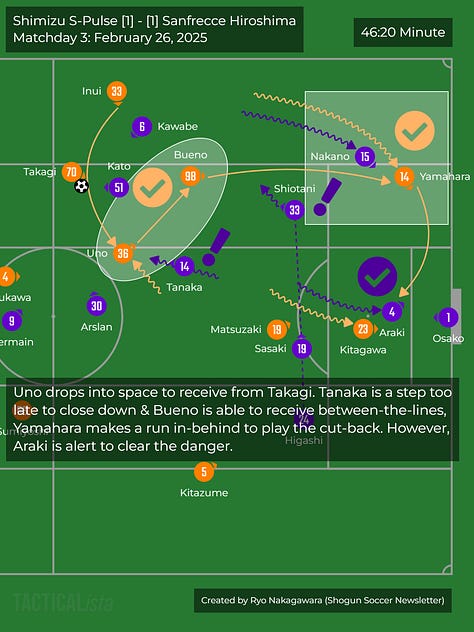

Throughout Skibbe’s time at Sanfrecce, a common theme has been to tweak the height of their Wing Backs to support the build-up depending on the opponent. The usual starters here are Shuto Nakano and Shunki Higashi who have quite different skill-sets but work really well. Nakano hasn’t had the barm-storming highlights he had last season so far but he is still a robust, physical, and versatile player that can play anywhere across the back-line. Higashi is more of a passer and takes a lot of set pieces with his pinpoint accurate Left foot.


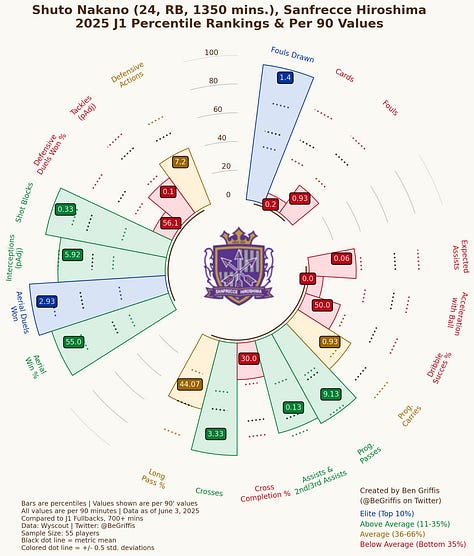
Satoshi Tanaka has fit into his new team extremely well, given the better quality of the teammates around him we've been able to see aspects we haven't been able to see before which is quite nice as a long time admirer from his Shonan days. Still one of the best ball-winners in the entire league and reads the game quite well.



Even with all these issues, five straight league wins on the bounce (before a home loss to Frontale…) has them keeping pace in the Asian Champions League spot chase. If (big if…) they start converting their chances then a title race isn’t far away either!
Vissel Kobe (6th, 30 Points)
9 Wins // 3 Draws // 6 Losses
Location // Stadium: Kobe // Noevir Stadium
Manager: Takayuki Yoshida
23 Goals (8th); 19 Conceded (7th)
21.34 xG (8th); 16.34 xGA (2nd)
Top goal scorer: Yuya Osako (5 goals)
Goalkeeper: Daiya Maekawa
Kobe were another team that started the season extremely poorly. The team suffered a huge amount of injuries during pre-season which amounted to them literally "playing the kids" against Shanghai Shenhua in their last ACL group stage game and then again versus Avispa Fukuoka in March. Kobe fans have a lot to feel aggrieved for with Shandong's forfeiture screwing Kobe over by changing the group stage table rankings. As a result they had to play a much harder opponent in Gwangju FC who then (deservedly, to be fair) knocked them out of the ACL. Only to later find out that Gwangju FC was actually under a transfer ban but they (and the KFA) somehow didn't realize it! It's taken them a while to get back to full steam and in the past month or so they have got right back in the thick of things near the top of the table.


In terms of tactics, Kobe's rise in the past few years have predicated on Yuya Osako and Yoshinori Muto in particular and it still remains the same today. Of course there are willing (and younger) runners in Taisei Miyashiro & Daiju Sasaki in support as well. These two get through a lot of work through their aggressive overlapping runs past a still strong Yuya Osako dropping deep or settling long balls to create time/space for his teammates. Even still, the absence of Yoshinori Muto due to injury has been felt and to a lesser extent that of Ryo Hatsuse who moved to try his luck in Europe. Kobe did move for Erik from Machida Zelvia as an emergency signing and it has worked out quite well so far.

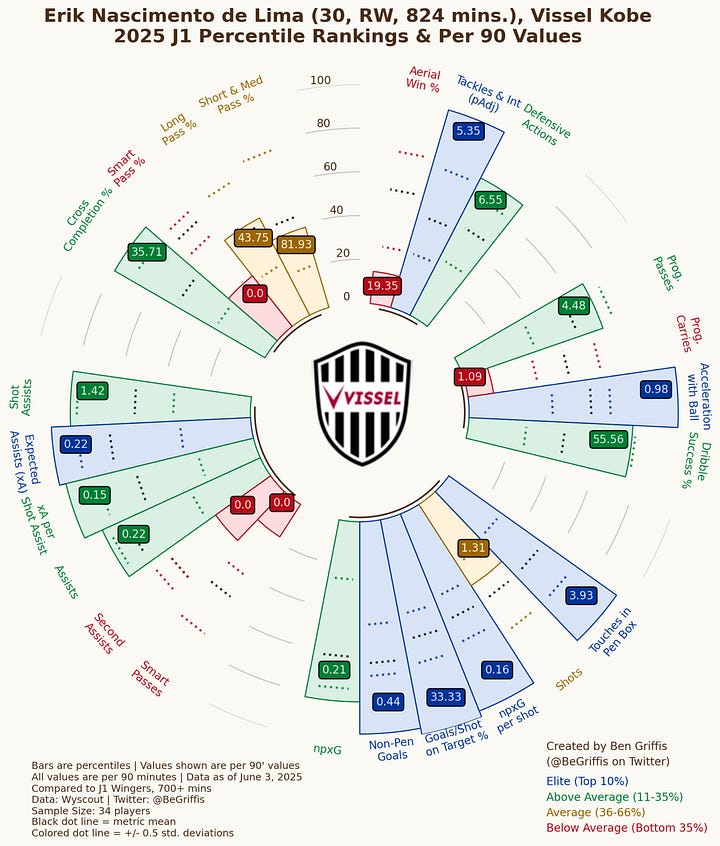


Gotoku Sakai has been playing more like a Wing Back in Kobe’s lopsided in-possession shape as they build-up in more of a Back 3 shape with Honda, Yamakawa, and Thuler. The back-line circulate the ball patiently to lure the press and create space in-behind or for Osako to drift around as a target. Quick combination play after a long ball has been a viable option too especially as Takahiro Ohgihara continues to pull the strings and being a reliable ball winner in the middle of the park. It’s a very mobile attack with midfielders and attackers rotating positions frequently to throw off their respective markers.
Nevertheless, like in previous seasons this team does have a huge reliance on set-pieces for chances with nearly 40% of their total goals coming from these situations.
Kobe continue to be an extremely physical side in defense. Matheus Thuler is the player that really stands out as an individual but the thing about Kobe’s defense is its effectiveness as a unit. Sliding side-to-side and being extremely strong in duels in the air and on the ground to win the ball. The entire team all track back to help double up on opponents too.
"Don't fix what isn't broken" has been the mantra for Kobe after back-to-back title wins in 2023 and 2024. This is a side that’s well drilled and have played with each other for a good amount of time now. They’ve stumbled a bit to start with their ACL failure and injury troubles but they’ve got the experience and know how to push back up toward the title race. For a mid-to-long term perspective I've been worried about their squad age curve for quite some time but until Osako, Muto, and Sakai actually break down for real, I don't think we'll see any massive changes to the squad or the tactics.
Kawasaki Frontale (7th, 29 Points)
7 Wins // 8 Draws // 3 Losses
Location // Stadium: Kawasaki // Todoroki Athletics Stadium
Manager: Shigetoshi Hasebe
30 Goals (tied 1st); 19 Conceded (tied 6th)
25.37 xG (1st); 17.88 xGA (5th)
Top goal scorer: Erison (5 goals)
Goalkeeper: Louis Yamaguchi
The two big stories for Kawasaki Frontale so far have been the appointment of Shigetoshi Hasebe as the successor to long-time manager Tohru Oniki along with their Asian Champions League journey. Under new guidance, Frontale had a very good campaign in Saudi Arabia but fell at the final hurdle against a well coached Al-Ahli team. As a result they had a lot of games in-hand to make-up!
As one might expect from a Shigetoshi Hasebe led team, Frontale’s defending has improved immensely under his guidance in a quick time. There’s been adjustments to form more of a mid-block and also how they press compared to last season.


Kota Takai has been in very good form and as a result is now a regular member of the Japan National team despite playing for a J.League side. He’s very strong in duels across the pitch (a tad too aggressive at times which is why he’s had so many fouls), very comfortable on the ball, and a good passer at all ranges.


Sota Miura was in great form with 5 league assists until his injury in the ACL final which has knocked him out for the medium-term (he has recently come back into the line-up in an Emperor’s Cup game in early June). Asahi Sasaki is an underrated part of the team, under Hasebe he has returned to playing at Full Back on either side instead of at Center Back.
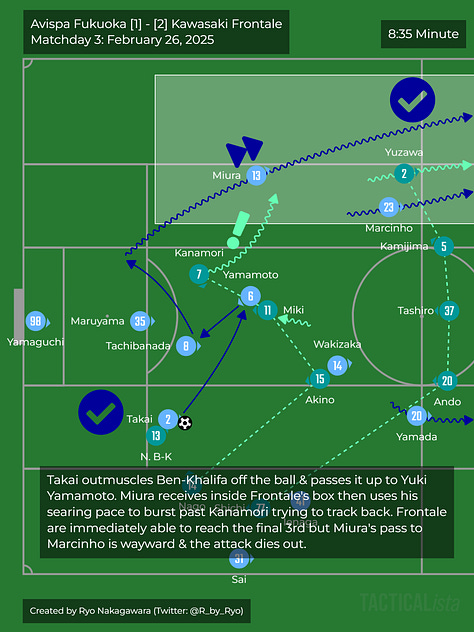


I do have some worries about Center Back though as it’s only a matter of when Kota Takai leaves. Cesar Haydar (aside from a miraculous super goal) has been quite poor while Yuichi Maruyama has been somewhat solid but getting quite old. On top of the fact that Shintaro Kurumaya and Jesiel are never fit, Frontale are going to need to find a starter-level Center Back somehow. Unfortunately for them, O.H. Leuven are apparently exercising Takuma Ominami’s buy option so the best and easiest choice is now closed to them! Despite looking fairly solid and having a decent xGA, this hasn’t translated to shutting opponents out and Frontale have dropped points. While I have a number of qualms about Louis Yamaguchi in goal, it really was time to move on from veteran Jung SR so some growing pains need to be tolerated I suppose.



In midfield, Yuki Yamamoto has been at the fore, pulling the strings in midfield. Alongside him has usually been So Kawahara. His energy and ball-winning supports Frontale’s possession game to flow well.




Special mention to Yuto Ozeki as he’s been a impactful in fairly limited minutes. He’s a player I wrote glowing reviews on when he was on loan at Fukushima United down in J3 and even I’m surprised as how he’s been able to show his skills at the J1 and ACL Elite level already. A big future lies ahead for him.
There’s been issues up front though as while Erison took over the starting spot with 5 goals, his big injury has Frontale reeling. Reinforcements at Striker is going to be a priority especially with Shin Yamada down in the doldrums so far this season and the only other candidates being an increasingly old Yu Kobayashi & a still very young (but promising) Soma Kanda. I wrote about Shin Yamada a few months ago, hopefully the strengths I discussed start to show up again later this season (he scored two in the Emperor’s Cup game a day before this newsletter released so, maybe…?).
Frontale lead the league in terms of goals scored, overall xG, xG per Shot and 3rd most in shots taken. It’s interesting that while Frontale’s non-penalty xG and goals scored are both league-leading, a solid 1/3rd of goals have come from set-pieces. Their 10 goals from these situations are considerably higher than the league average attesting to the amount of set-piece work that Frontale must be doing in training.
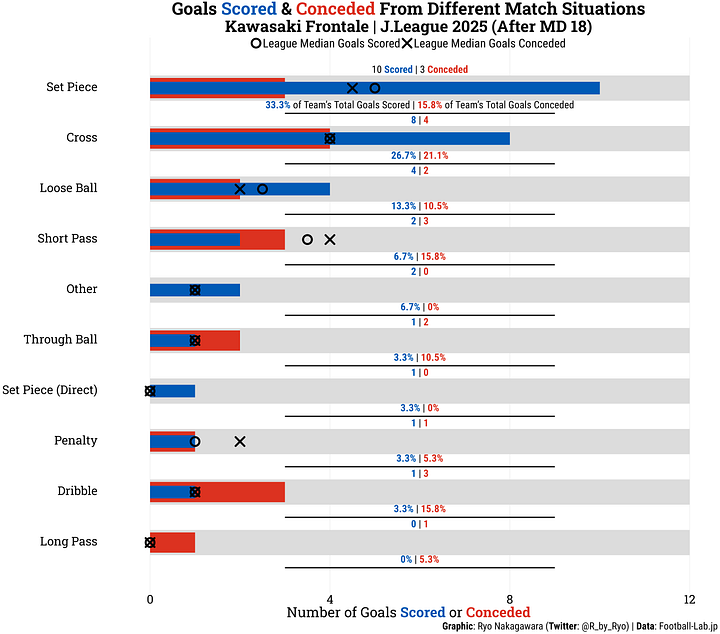

Despite the disappointment of an Asian Champions League Elite final defeat there is a lot to look forward to as they fully concentrate on the league. Frontale have been playing quite well but they just seem to have a bad habit of dropping points and not being able to completely close games out has been their undoing. With no further continental involvement, the schedule lightens up so Frontale should have more time to spend on the training ground to reinforce Hasebe’s methods and push up the table.
Cerezo Osaka (8th, 29 Points)
8 Wins // 5 Draws // 7 Losses
Location // Stadium: Osaka // Yodoko Sakura Stadium
Manager: Arthur Papas
30 Goals (tied 1st); 26 Conceded (18th)
25.2 xG (2nd); 27.07 xGA (20th)
Top goal scorer: Rafael Ratão (8 goals)
Goalkeeper: Koki Fukui
I was very skeptical of the appointment of Arthur Papas in pre-season. However, I've been proven wrong, when I watch Cerezo I quite like what I see and the changes from the rather mixed Akio Kogiku era are quite apparent!


Even their defensive issues can be somewhat waved away as the trade-off for their possession structure and how they want to attack... The huge loss of Shunta Tanaka to injury will also mean a signing is of top priority as I don't think Hinata Kida is quite good enough to be the main guy at the base of midfield going forward (he's not a bad player, he’s just... OK). Tanaka has been their best ball winner by some margin in the team and unfortunately for Cerezo fans, guess who is the next best? Sota Kitano who is on his way to Europe!


As of now they've had to improvise with Shinji Kagawa and Motohiko Nakajima in the double pivot. Thankfully, they haven't gone back to trying Satoki Uejo or Masaya Shibayama there (I'm sure most Cerezo fans remember Akio Kogiku's odd experiments in previous seasons). Special mention should be given to Motohiko Nakajima who has been very busy being shifted around to almost every possible position outside of the Back 4 (… and goalkeeper of course).
In recent games, Papas has shifted to a Back 3 with Shinnosuke Hatanaka stepping forward to act as the single pivot in-possession and it’s working somewhat well. The move to a Back 3 has also benefited Niko Takahashi as he's made the Left Wing Back spot his own now after struggling to win a spot as a conventional Left Back over the past two seasons. Koki Fukui has been pretty decent between the sticks despite this being his first actual year in his career that he is making regular starts, all at the age of 29!
One of the biggest issues for Cerezo in the early part of their season was that the results weren't tracking with their somewhat decent performances. Rafael Ratão, among others but him first and foremost, was quite guilty of missing tons of chances that let leads slip and turned surefire wins into draws or even losses. However, in the past month or so, they've finally started to convert chances and Cerezo have finally climbed out of the bottom half to a more respectable (and more aligned to their performances) 8th place. The Brazilian striker, Ratão, has actually scored 8 goals now from 6.29 xG which is quite a turnaround from his numbers in the beginning of the season. Lucas Fernandes continues to be one of the most dangerous chance creators, not just on Cerezo but in the entire J.League, even if most are simply coming from his vicious set piece deliveries and crosses.



Of course, the big star of the Cerezo show this season has definitely been Sota Kitano. I do feel like he would've been picked for the experimental June national team squad if it wasn't for Red Bull Salzburg playing at the Club World Cup. Kitano has been electric for Cerezo. He has great technical ability and is able to drive the team forward with his dribbling and carrying. I wrote a detailed piece on him a month ago so check that out if you want to know more.

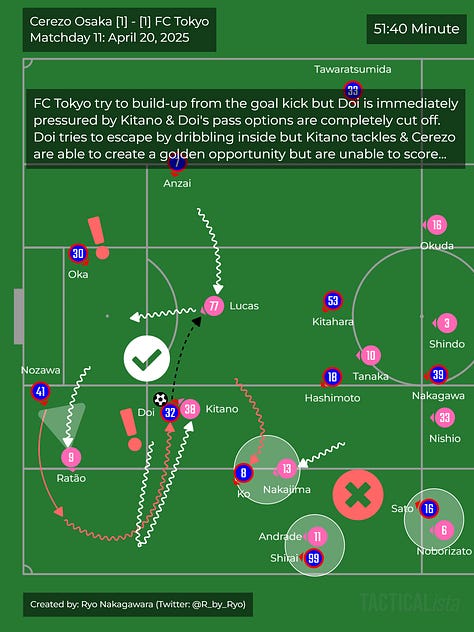

Overall though, defense is still a big problem but if they can continue to score goals at the other end it may give Papas more time to figure things out. They have conceded the most non-penalty xG (27.07) on top of actually conceding the 3rd most goals (26), so there really isn’t a silver lining here defensively. Cerezo are especially poor when it comes to defending crosses as they have conceded 34.6% of their goals in this manner. Something to work on during the summer mini-breaks.
There will definitely need to be some incoming transfers over the summer as I think the squad is very oddly full in certain areas and bare-bones in others. In recent weeks as I was writing this up, Cerezo have indeed brought in reinforcements. Malaysian international Dion Cools and Kyohei Yoshino have come to add a bit of depth and competition in the defense line.
Shimizu S-Pulse (9th, 25 Points)
7 Wins // 4 Draws // 8 Losses
Location // Stadium: Shimizu // IAI Stadium Nihondaira
Manager: Tadahiro Akiba
26 Goals (6th); 26 Conceded (17th)
20.35 xG (11th); 21.23 xGA (13th)
Top goal scorer: Koya Kitagawa (3 goals plus 5 penalties)
Goalkeeper: Yuya Oki
I had a lot of worries for S-Pulse going into this season. Watching S-Pulse over the past few seasons in J2, I didn't think Tadahiro Akiba was much of a tactician and S-Pulse had a huge financial/talent advantage relative to J2 that got them back into J1 (even that took two tries after the 2023 season debacle). For reference, see my thoughts in my J2 season review from last year. However, they've been able to really mitigate their opponent’s strengths in more than a few games through (what I imagine) good opposition scouting and coaching.
The key thing about S-Pulse to me is that compared to last season they are not so heavily reliant on Takashi Inui for everything, especially in bringing the ball forwards. In this aspect a lot of praise can be pointed toward the successful partnership of Zento Uno and Bueno in supporting the defenders as pass receivers. Their tenacity in screening the defense with their good positioning and aggressive pressing should also be noted. I was hoping to watch more of Zento Uno when he was promoted with Machida last year but he couldn't get game time & had to drop back down to J2 with S-Pulse. Good to see a young player pick themselves back up & thrive! Uno's stats don't really "pop" but when you watch S-Pulse play, you can see how important he is to the team.

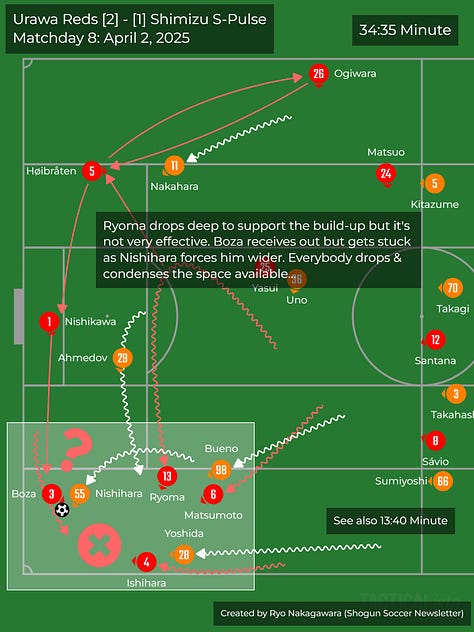

Of course, Takashi Inui still gives S-Pulse those moments of magic to impact the game and for a newly promoted team, that's a big boost. Kai Matsuzaki is another that had to drop down to J2 after his step-up to Urawa Reds didn't go quite well but he's genuinely worked hard to get back to the J1 level. His dribbling and creativity has been useful for S-Pulse so far this season.
Koya Kitagawa continues to show excellent form, stamping his place in the side as the ace striker despite under pressure from the presence of few foreign attackers like Ahmedov and Douglas Tanque. However of Kitagawa’s 8 goals, 5 have been penalties! This is actually nearly a quarter of S-Pulse’s entire goal haul. This is one of the concerns I have about S-Pulse, they simply aren’t scoring enough in open-play. They do take a decent number of shots per game but they aren’t of great quality…
Another player I've liked is Sen Takagi. I think he has quite solid fundamental skills and his versatility allows S-Pulse to seamlessly shift between a Back 3 and Back 4 throughout the game. He's a very handy player to have and has made the step up to the J1 level quite well! Might be one to watch if he can make the EAFF squad in July.



Despite having guys like Takagi and Sumiyoshi who are individually good in the air, S-Pulse have conceded quite a lot from set-pieces and crosses which might indicate that there are issues unrelated to personnel at the back and more to due with structural or organizational issues. I suppose it didn’t help that there was a short period where Zento Uno was forced into Center Back due to injuries as Kento Haneda proved to be simply not good enough at the J1 level.
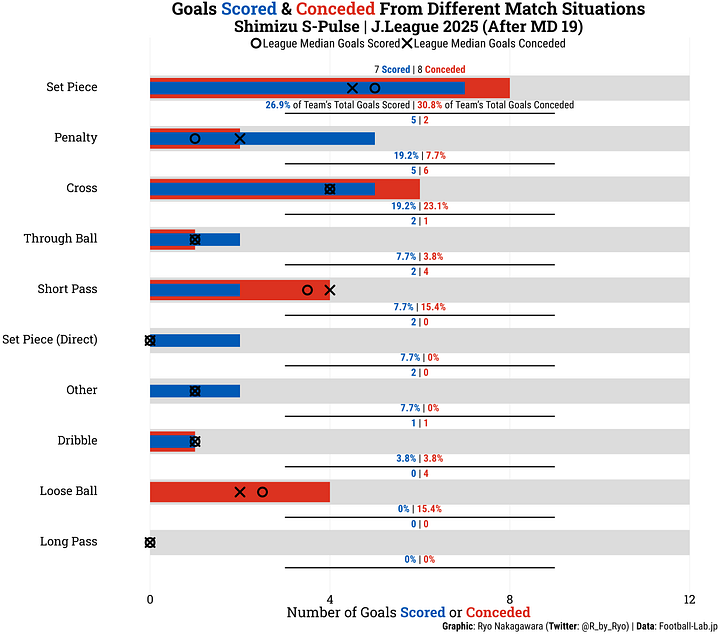

Overall, S-Pulse so far have been just about… OK. Mediocre but not outright bad in their return to J1. There are still plenty of games left to go though. The fact that they are in 9th with 25 points already on board definitely helps but they can’t rest on their laurels quite yet as the table is quite tight.
Machida Zelvia (10th, 25 Points)
7 Wins // 4 Draws // 8 Losses
Location // Stadium: Machida // Machida GION Stadium
Manager: Go Kuroda
22 Goals (11th); 23 Conceded (13th)
22.09 xG (7th); 16.39 xGA (3rd)
Top goal scorer: Takmua Nishimura (5 goals)
Goalkeeper: Kosei Tani
Are Machida Zelvia suffering from "2nd season syndrome"? Kind of but not really. To be sure, they aren't going to be near the relegation battle by any stretch of the imagination but the heights of last season may not be repeated given their current form and the resurgence of other clubs. Their underlying numbers look pretty decent, especially their defense which has been excellent. Unfortunately, the reality is that they haven’t been able to score and that opponents have been able to finish their chances quite well despite the meager opportunities given up by Machida Zelvia.
Go Kuroda's time at the club has been known for their long ball tactics but this season has seen an improvement on more patient tactics as well. They are making a lot more use of spreading the ball from side-to-side and punching diagonal balls between-the-lines. Of course, the long diagonals to Oh Se-Hun or the Wing Backs still exist and are quite effective versus most teams. Yuki Soma in particular has been in excellent form this season, almost single-handily carrying the attack on his shoulders. While his European career was cut short (I had various concerns about him making it over there), he’s always been very good at the J1 level and he’s bulked up quite a bit from his time with Casa Pia.



In attack, unlike last season where they ran “hot” on their xG to Goals differential, they just can't seem to put away the kind of chances that Zelvia are normally good at scoring, even if the actual xG quality of those shots aren't particularly great). Zelvia play in a very particular way, creating chances geared specifically toward the Zelvia attacking player talent pool but for whatever reason this season they haven’t been able to convert.
As mentioned earlier, Zelvia continue to be quite good defensively but maybe far more unlucky in the goals they conceded overall. Ibrahim Dresevic, Daihachi Okamura and Gen Shoji are as good of a Back 3 as they come in the league! Really impressive stuff. However I will note that Machida’s pressing with the 5-2-3, especially against Back 4s has been a struggle all season long that needs solving.

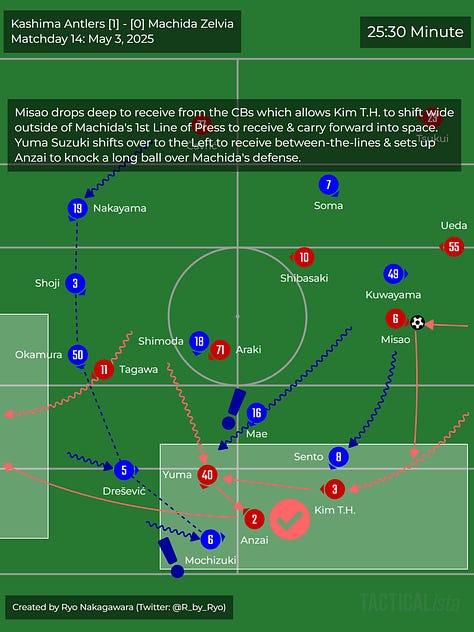

Another huge problem is that Zelvia have already given up more set-piece/crossing goals already this season than the entirety of last season (one)! It’s really odd considering how as individuals their defenders are all quite good in the air. All of this on top of the fact that their 16.39 xGA is the 3rd best in the league!
They are stuck in a bit of a rut but given how tight the table is, Zelvia still have some leeway to turn it around, even if they aren't really title contenders anymore. More importantly for them is how they will navigate their maiden Asian Champions League adventure with a busy schedule to come in the autumn months!
Fagiano Okayama (11th, 24 Points)
6 Wins // 6 Draws // 7 Losses
Location // Stadium: Okayama // City Light Stadium
Manager: Takashi Kiyama
16 Goals (16th); 17 Conceded (3rd)
20.69 xG (10th); 21.40 xGA (14th)
Top goal scorer: Ryunosuke Sato (4 goals)
Goalkeeper: Svend Brodersen
When I was watching Fagiano Okayama in J2 last season, my impression of them was a stodgy and disciplined team. They played in a very compact mid-block. However, they were very conservative and lacking a whole lot of attacking prowess besides launching it to Lucao or Gleyson to bulldoze past distinctly average J2 level defenders. Given their squad and limitations I thought they would have a very hard time surviving at the J1 level. For the most part they've proven me wrong although it's clear there are still concerns about consistent quality in the squad that can't just be hand-waved away because of the current somewhat OK form.


Okayama have a good game plan to set up in their mid-block, win the ball, and counter but they don't seem to have the quality to consistently take advantage of their opponent's mistakes. Lucao, in the absence of Gleyson, has been doing a decent job but he can't quite bulldoze past J1 defenders like he did in J2. Nevertheless, his ability to hold up the ball with his bull-like strength gives Okayama the reprieve they need to push their lines back up the pitch. I also want to highlight Ataru Esaka, seeing him back in the J.League is a delight to see. Sure, he's much older now but uses all that nous to squeeze some juice out of Okayama’s attacking pieces.
Ryunosuke Sato (on loan from FC Tokyo) has been a revelation at Wing Back despite spending most of his career as an attacker. He's shown a remarkable intensity at the J1 level at just 18 years old. Hard running and awareness in defense and attack, even chipping in with a few important goals (he’s the top goal scorer!). His performances have led to a full Japan National Team call-up in June, even if it's an experimental one by Hajime Moriyasu.


I've been impressed with Ibuki Fujita for Fagiano Okayama this season. Not a lot of mobility now obviously (the guy is 34 years old!) but uses his experience to anticipate & take good positions to win the ball, plus sharp passing to start (counter) attacks...!


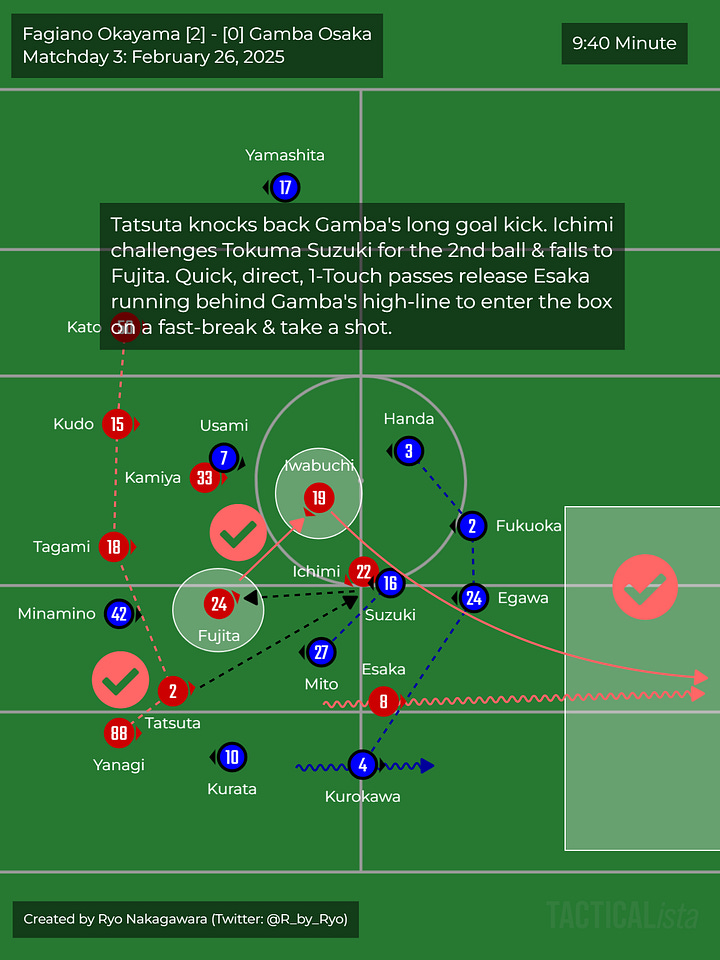

On the defensive side of things, I do feel that opponents can exploit the gaps around the double-pivot. When the midfielders try to cover for the Front 3, that simply creates even more spaces so Okayama will need to be careful about that and properly plan on how to deal with situations where teams try to shift their players around. What does mitigate this is their Back 3 plus the Wing Backs allow them to quickly retreat in numbers and pack the box.



Okayama will hope their legs can last, especially with the enormously hot summer to come that will stretch their defensive strategy to its limit. They need to be careful as although the “Goals Conceded” column looks quite rosy, the underlying xGA numbers are a bit more humbling and they have a lot to thank Svend Brodersen for his shot-stopping in difficult situations. The German is 3rd in the league for “Goals Prevented” according to FotMob.

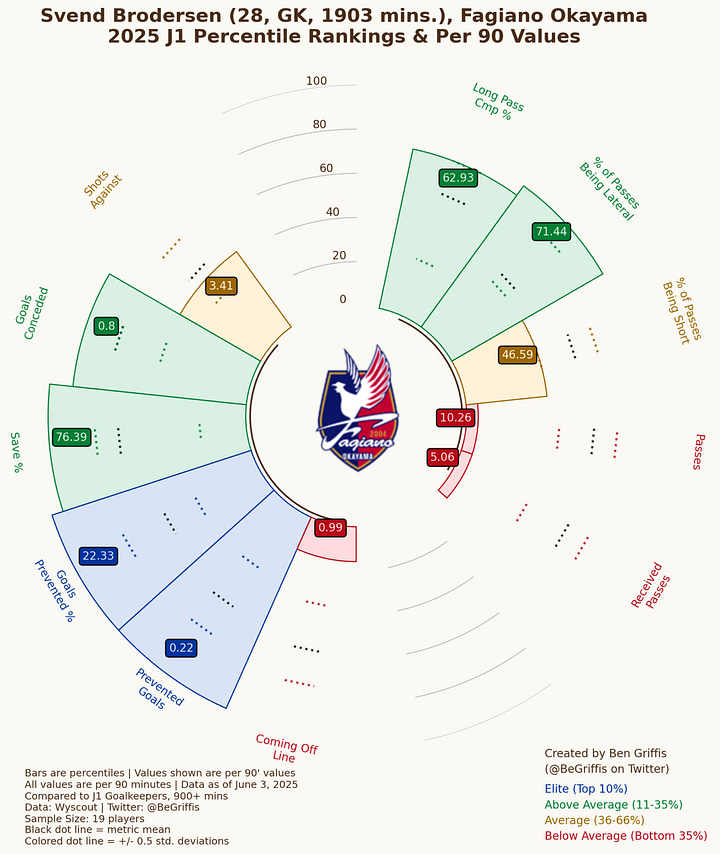
Currently they are also helped by the fact that Nagoya Grampus, FC Tokyo, and Yokohama F. Marinos are inexplicably floundering in the relegation battle as well. If those teams start picking up steam, then it'll put a lot more pressure on Okayama to keep themselves afloat. To end on a positive note, I've seen how Okayama have taken to J1 with a whole lot of enthusiasm in their debut season with the entire city coming together which is a great advertisement for the J.League's ability to rally citizens for a common goal.
Gamba Osaka (12th, 24 Points)
7 Wins // 3 Draws // 9 Losses
Location // Stadium: Osaka // Panasonic Stadium
Manager: Dani Poyatos (Spain)
23 Goals (9th); 27 Conceded (tied 20th)
22.69 xG (5th); 21.15 xGA (11th)
Top goal scorer: Ryoya Yamashita (5 goals)
Goalkeeper: Jun Ichimori
It's been a very weird, inconsistent, and mixed season so far for Gamba Osaka. Brilliant games like against Nagoya but then they'll fall way short a week later! There's been some poor luck and injury troubles involved of course but nevertheless, it's been a disappointing season for a Gamba team that finished in 4th last year and finally looked like things were going to click with Spanish manager Dani Poyatos at the helm.


Dawhan's departure to China in pre-season had a huge impact on the team. Rin Mito has not been good enough and is also not the same midfielder profile as Dawhan anyway. It's been an issue as Gamba can't play Neta Lavi & Tokuma Suzuki week-in, week-out for the entirety of the season, especially with a maiden ACL2 campaign coming up in the autumn that'll stretch Gamba's squad quite thin. Veteran Shu Kurata along with Makoto Mitsuta have also dropped into the double-pivot but neither are good fits there. However, in recent weeks some good news for the Gamba faithful as the club announced the arrival of ex-FC Tokyo midfield dynamo Shuto Abe. To me, this is a very logical move as he is versatile to fill in different midfield roles and brings the physicality and mobility they've been lacking with Dawhan's departure!
So far though, the Neta Lavi and Tokuma Suzuki pairing, when they've been able to play together have looked really good. Lavi especially has had various fitness issues & lots of travel fatigue from playing for the Israel National Team in the past but he has been showing his best form this season with crisp passing, press-resistance, and defensive alertness.




A big injury to key wide man Welton forced some weird formation changes by Poyatos that didn't come off... but he has since returned in recent weeks with the ever rapid Ryoya Yamashita having to take up a lot of the work out wide so far. Yamashita actually leads the team with 5 goals! The arrival of Denis Hummet has given a real kick to Issam Jebali to get back into some form and he's responded with 4 goals along with his good physical hold-up play. Special mention to Juan Alano who has gone under the radar a bit but surprisingly has 6 assists!
In defense, Shinnosuke Nakatani continues to be a very good leader. The issue is picking the right partner for him as neither Shota Fukuoka nor Shogo Sasaki seem to be good enough defenders for the rigors of J1 attacks despite their clear quality on the ball. Genta Miura is still coming back from a long-term injury so hasn't made a return yet. A star to highlight has been Riku Handa. Really solid in defending 1v1, very good at keeping the ball moving with his technique and passing without creating a fuss with unnecessary flashy moves. He's one I think might get a transfer to Europe soon so it'll be nervy times for Gamba supporters.

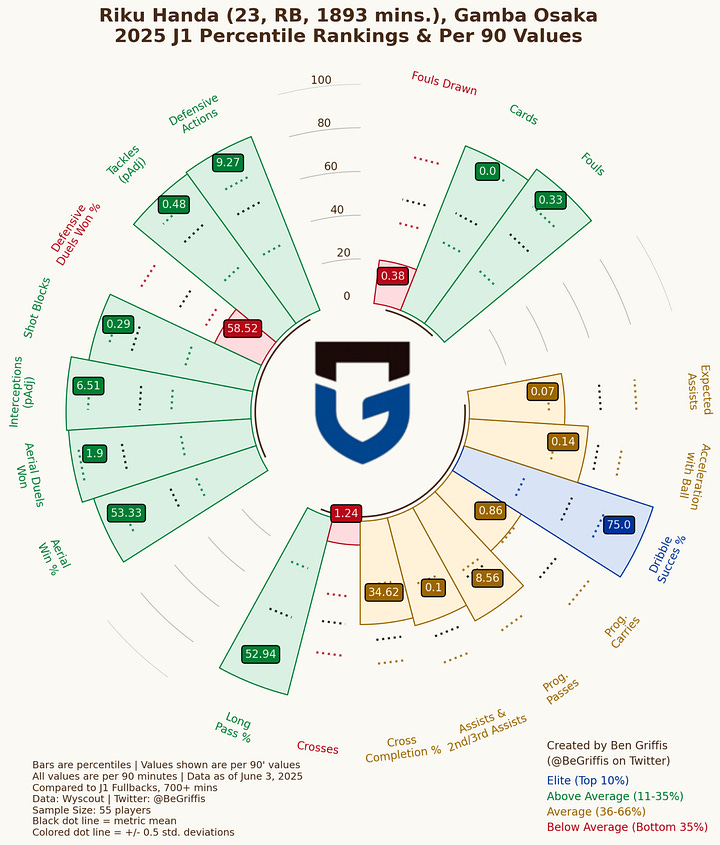
Gamba may feel a bit hard done by considering that even though they have conceded the most goals (27, tied with Albirex Niigata), they’ve actually only conceded 21.15 xGA which is 11th most in the league.


I imagine further summer reinforcements will be needed to make a further push up the table as there's a solid core but still lacking that little "something". Their data has been all over the place because Gamba have been so inconsistent. What is clear is that while they certainly aren’t bad… they do need to improve things on either side of the ball as their underlying numbers are only just “OK”.
Tokyo Verdy (13rd, 24 Points)
6 Wins / 6 Draws / 7 Losses
Location // Stadium: Ajinomoto Stadium
Manager: Hiroshi Jofuku
13 Goals (tied 20th); 18 Conceded (5th)
14.13 xG (20th); 18.75 xGA (6th)
Top goal scorer: Yuto Tsunashima (3 goals)
Goalkeeper: Matheus Vidotto
Verdy are a team that's definitely having "2nd season syndrome" back in J1. The honeymoon period is over after a very good 2024 season and it's been much tougher going so far in 2025.
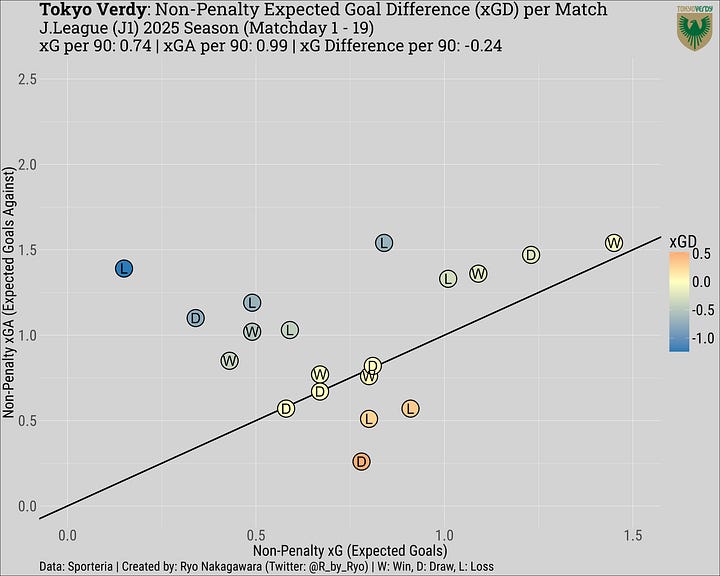

In terms of defense, overall Verdy are honestly quite hard to crack. They have conceded 18 goals (5th) from 18.75 xGA (6th) so their defensive numbers track well with their results. It helps that they are particularly good at pressing the opponent’s build-up. Even when they don’t win the ball outright, they cause problems.
In possession, there’s decent variations in the build-up especially when Hiroto Taniguchi is involved. Also, like last season Kosuke Saito & Koki Morita do a good job balancing between dropping back and staying between-the-lines in possession.



However... the big and glaring problem is Verdy's complete lack of attacking prowess. This is especially clear now that the players up top aren't catching fire and over-performing on their xG like last season. Verdy are absolute rock bottom by some distance in goals scored, final 3rd entries, box entries, shots taken, shots on target, etc.


Despite all the positives I mentioned previously about the build-up, things really just grind to a halt in the final 3rd. Verdy's chance creation is simply having the wing backs cross to only one or two recognizable targets in Kimura/Someno inside the box against a fully set defense. There's just not enough done to pull opponents away and create space before sending the cross in, very easy for opponents to just sit and wait, let Verdy cross to clear and counter. This team is full of lots of hard workers but nowhere near enough guile and creativity! It's a bit worrying and quite poignant that Yuto Tsunashima of all people has scored the most goals for Verdy so far this season! It's pretty dire to watch, honestly.
Manager Hiroshi Jofuku still has a lot of goodwill for his results in the past few years but football fans can be fickle and if both performances and results don't improve it may be tough for the experienced manager. I still can't imagine they'll get rid of him mid-season though to be clear. What should save Verdy is that there are clearly worse teams below them, and in Yamami, Kimura, and even Someno they've clearly got some players who can catch fire for a few months and score some bangers to offset the team's lack of quality/quantity in attack.
Nagoya Grampus (14th, 23 Points)
6 Wins // 5 Draws // 8 Losses
Location // Stadium: Nagoya / Toyota // Toyota Stadium
Manager: Kenta Hasegawa
24 Goals (7th); 26 Conceded (16th)
20.85 xG (9th); 19.74 xGA (9th)
Top goal scorer: Sho Inagaki (7 goals)
Goalkeeper: Alexandre Pisano / Daniel Schmidt
Much like the start of the 2024 season, Grampus started 2025 in awful form as they didn't win a game until late March, seven whole games into the season! However in the past month, the Nagoya-based side have gone five games undefeated and they are just about able to keep their heads above water at the moment. Do note that the over 3 xG or so that they created against Urawa is doing a lot to prop up their recent xG numbers below…
The back-line has seen a reshuffling and the addition of Teruki Hara has been a positive as its made shifting between a Back 3 and Back 4 in-possession an easy transition throughout games. However the actual build-up and game plan still doesn't feel quite right. There’s lots of flick-ons from rushed vertical passes under pressure but the possession sequences are not clean and not replicable. Often times their build-up is prone to counterattacks from loose balls and inaccurate passes, especially as players like Sho Inagaki shift wide to support build-up which leaves Center vulnerable to counterattack as Shiihashi (or whoever) is left alone in large spaces. Throughout Hasegawa’s tenure I’ve had difficulty in understanding what Grampus want to do with the ball in-possession.
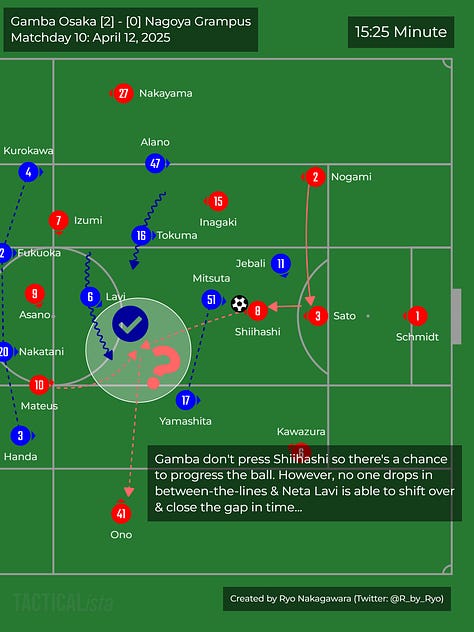

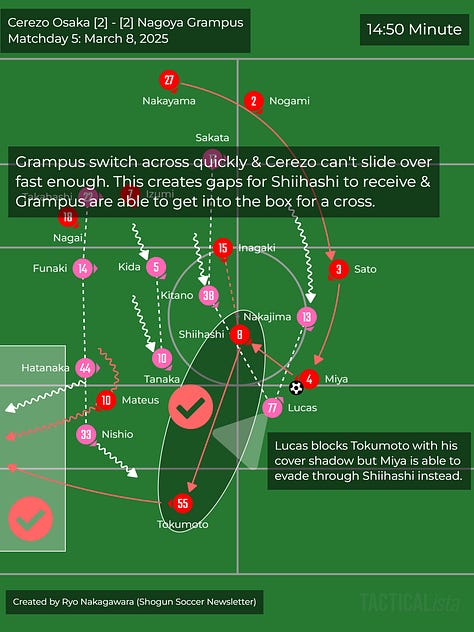
Overall, the attacking metrics have been in the gutter for most of the season, only recovering a bit over the past month or so. They have notably been propped up by some really good individual play with 16.7% of goals coming from dribbles which is significantly higher than the league average!


Grampus are 17th in terms of final 3rd entries and 18th in actually getting inside the opponent’s penalty area. In that regard I’m not sure why Tsukasa Morishima and Taichi Kikuchi aren't playing more as they would definitely add more to Grampus in-possession than the starting alternatives... even if you would have to give up other aspects in the trade-off.
The biggest surprise for Grampus has been the emergence of Sho Inagaki as the biggest source of goals while also continuing to be one of the hardest working in defense at the other end of the pitch. 7 goals! His record was 8 in the entirety of the 2021 season and we're only at the halfway point in 2025. The Japanese Frank Lampard in the flesh!
Their underlying defense numbers aren't horrible but nevertheless they have conceded a lot of goals. Compared to the start of the season though, both the underlying numbers and the actual goals conceded are trending in a very good direction!
A difficulty that Grampus have had to deal with are the various goalkeeper fitness issues which has seen a rotating cast between-the-sticks. However, this has been a boon for the young teenager Alexandre Pisano, who has since emerged as a genuine contender between the sticks. I might even say that Pisano could keep his spot even if Daniel Schmidt returns from injury!
You watch their games and aren’t really enthused about their attack or defense but the underlying numbers show just a very mid-table team at either end of the pitch. For most clubs this wouldn’t be bad but how Kenta Hasegawa hasn't been relieved of his duties is mind-boggling to me given the significant financial outlay and trust throughout his tenure. Yet he's only delivered consistent bottom half results that really shouldn't be waved away by a solitary League Cup win last year. It does seem like the front office just don't want to pay out his contract to terminate him and the distinct lack of alternative candidate managers out in the wild? There's a collection of good (if, on the whole, aging) players here and Grampus can certainly do a lot more than they have in the past few years. I’ve mentioned this quite often in the past year or so but Grampus do have a very old squad which is a ticking time bomb waiting to explode if they don’t start moving more players on soon.
Some momentum shift in the past month may lead to an upward trajectory as Grampus start to figure stuff out plus the recent returns of strikers in Kasper Junker and Yuya Yamagishi from injury are also good signs.
Avispa Fukuoka (15th, 23 Points)
6 Wins // 5 Draws // 8 Losses
Location // Stadium: Fukuoka // Best Denki Stadium
Manager: Kim Myung-hwi
15 Goals (17th); 19 Conceded (6th)
19.61 xG (14th); 19.39 xGA (8th)
Top goal scorer: Tomoya Miki (2 Goals plus 2 penalties)
Goalkeeper: Masaaki Murakami
Around April I was like, "well, they're certainly not going to be in the relegation battle this season which is a big improvement"... but unfortunately for Avispa Fukuoka they have no won a single game since their April 12th win against Yokohama F. Marinos, a nine game win-less streak which has them crashing back down into their usual relegation fight.
Avispa Fukuoka signaled a change in strategy from the long ball or counterattack era under Shigetoshi Hasebe to a more possession-based approach. To headline this transformation was the hiring of Kim Myung-Hwi, a controversial appointment due to his past power harassment issues. In terms of the football, there has been an astounding change with Avispa Fukuoka looking far more tidy in possession. Unlike a lot of teams in this mold, they have been able to turn this possession into shots despite not getting into the final 3rd nor the box very often. However, the clear fact remains that they are struggling to score goals. Their way of ball progression and chance creation is simply not putting Avispa’s strikers and other players in the most optimal place to take shots.


Tomoya Miki has been the star man for his team as the midfielder has not only scored the most goals (4) but is a huge conduit for Avispa to progress from the back with his clever positioning and passing.
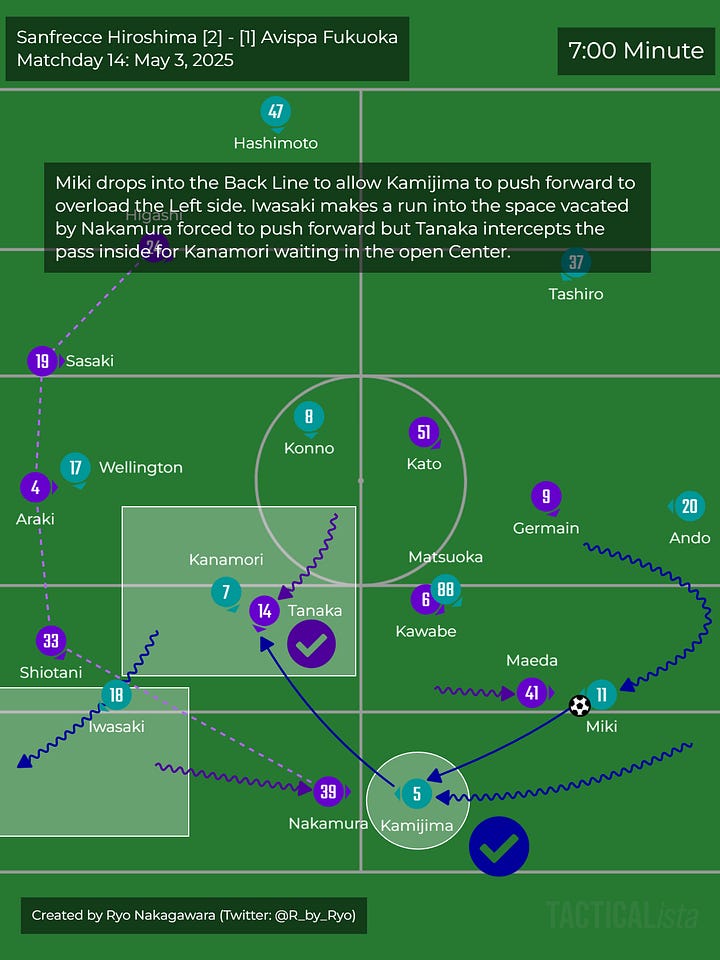

Further forward, Kazuya Konno and Kazuki Fujimoto bring a lot of direct dribbling threat although they haven't quite gotten on the score sheet as they hoped. Their end-product has noticeably tanked compared to previous seasons…


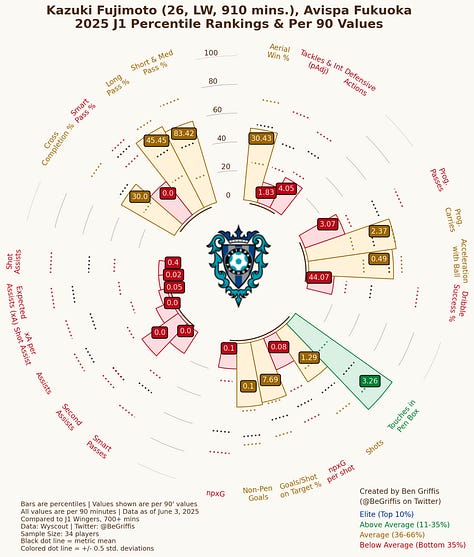
In defense, Tomoya Ando has taken to the J1 level quite well after a number of years impressing for Oita Trinita in J2. It’s also quite telling of Avispa's problems that Ando of all players is the team's second top goal scorer (if you don’t include penalties, he’s actually top)… It's a new manager but Avispa still keep doing the "Goalkeeper Roulette" between Nagaishi and Murakami, but it seems that Kim Myung-Hwi has finally decided on Masaaki Murakami in recent weeks.
After a seemingly decent start to the season, Avispa have slid quickly down the table. They have now not won a game in nine games, only 4 points above the relegation zone having played a game more than most of the teams below them! With a number of breaks in league play coming up, Avispa will need to retool and rethink if they want to survive a very packed league.
Shonan Bellmare (16th, 22 Points)
6 Wins // 4 Draws // 9 Losses
Location // Stadium: Shonan // Lemon Gas Stadium Hiratsuka
Manager: Satoshi Yamaguchi
14 Goals (18th); 23 Conceded (12th)
20.10 xG (13th); 19.21 xGA (7th)
Top goal scorer: Akito Suzuki & Sho Fukuda (3 goals)
Goalkeeper: Naoto Kamifukumoto
Shonan Bellmare had a tremendous start to their season going 3-2-0 in the first 5 games of the season to set the pace early on. However, it's been extremely rocky since then as they have only won 3 of their next 13. The early season wasn’t necessarily a fluke as Shonan’s underlying numbers were actually quite good but then they sizzled out in line with their results.
Now Shonan find themselves back in the usual bottom half fight against relegation with recent losses against fellow relegation battlers in Yokohama FC and Albirex Niigata being especially painful.
Compared to previous years things are much smoother in the build-up especially with Junnosuke Suzuki's involvement starting from last season. Suzuki’s mix of ball-carrying, passing, and supporting under/overlapping movements (due to him originally being a midfielder) has added an extra bit of ball progression for Shonan. His performances over the past year have earned him a call up to the full national team in June. NOTE: His debut against Indonesia went very well. Big things ahead of him in the near future.


However, chance creation when opponents simply sit off them is an issue. Shonan show plenty of nice combination play in the middle 3rd when the pair of strikers (Sho Fukuda & Akito Suzuki) drop off and get involved alongside the intelligent runs of Taiyo Hiraoka but not enough is done to really make a difference closer to goal. The most effective chance creation has been through Taiga Hata’s lung busting runs on the Left followed by a cross.




Sho Fukuda has been a huge avenue for ball-progression in transition or in possession with his ball-carrying ability. He is also extremely sharp out-of-possession. The speed at which he counterpresses the opponent when Shonan lose the ball is quite astounding to watch. For more detail on Fukuda, I wrote up a quick report on him after news of his impending transfer to Brondby IF.
Overall, Shonan take the 4th least shots per game, the 7th least shots on target, which all resulted in the 4th least amount of goals per game. In the beginning of the season, they were able to make their limited chances count but now the tides have turned.
On the opposite side of the pitch, Shonan continue to be poor in defense especially in set-pieces (30% of goals conceded) with Naoto Kamifukumoto being called upon throughout games. The big man continues to provide assurance through his passing and steely nerves when pressed along with his “Kami-like” saves. What is interesting to note that their underlying xGA numbers are nowhere near relegation zone levels (7th best in the league).


Shonan were able to stock up on points at the beginning of the season but things are looking dicey now especially with Nagoya Grampus and potentially Yokohama F. Marinos looking like they could push back up the table. It's another worrying season looking behind their shoulders ahead for Shonan unless things improve.
Yokohama FC (17th, 19 Points)
5 Wins // 4 Draws // 10 Losses
Location // Stadium: Yokohama // Nippatsu Mitsuzawa Stadium
Manager: Shuhei Yomoda
13 Goals (tied 20th); 23 Conceded (9th)
18.67 xG (16th); 16.59 xGA (4th)
Top goal scorer: Lukian (3 goals plus 2 penalties)
Goalkeeper: Akinori Ichikawa
At this point we all know what Yokohama FC are about. A clear game plan in defending in their solid 5-4-1 mid-block and then counterattack through the Wing Backs or lumping it toward the big strikers. Shuhei Yomoda has been at the club for the past few seasons now yo-yo-ing between J1 and J2 so he's got the squad knowing exactly how/why they want to execute the game plan. However, it's still a problem that the way they create chances always means there's going to be a high amount of variability as the probability of scoring from normal aerial crosses is very low in general! This is certainly a squad build exactly to these specifications though. With Solomon Sakuragawa and Musashi Suzuki up top they bring the physicality and hold-up play necessary to bide time for the rest of the team to push up.
Another big avenue of Yokohama FC's ball progression is through Kaili Shimbo whose speed and ball carrying ability has been carried over from his time in J2 and J3. If you're interested, I wrote about Kaili Shimbo in considerable detail when he was playing for Renofa Yamaguchi last year.
The way Shimbo bursts down the Left side also allows Akito Fukumori to belatedly join the attack. The Left Wing Back, if he can't dribble past his opponent, can then simply choose to pass backwards to Fukumori in support so he can launch one of his super accurate crosses to the far post!


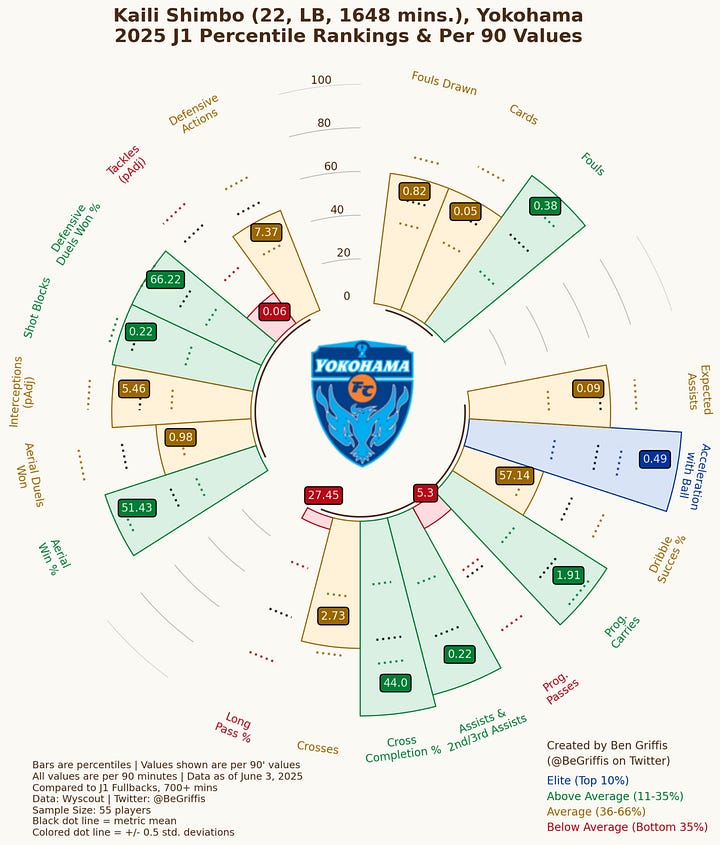

Nevertheless, as advertised, Yokohama FC continue to be one of the most frustrating sides to play against with their defensive numbers being genuinely impressive.

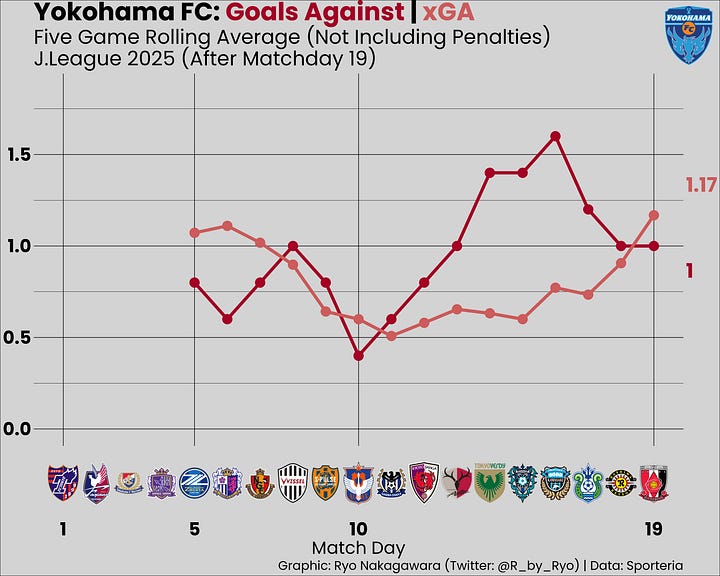
On the defensive side of things, I've liked Yuri Lara for the past few years now. He's got clear technical limitations but makes up for it with guts, robustness, and mobility as a decent lower-table battling midfielder archetype at the J.League level.
Overall, though Yokohama FC's limitations are clear to see though and they will still be one of the favorites for relegation unless one or two of the "bigger" clubs in the fight continue to struggle.
FC Tokyo (18th, 19 Points)
5 Wins // 4 Draws // 9 Losses
Location // Stadium: Tokyo // Ajinomoto Stadium
Manager: Rikizo Matsuhashi
17 Goals (15th); 26 Conceded (14th)
18.14 xG (17th); 21.04 xGA (10th)
Top goal scorer: Marcelo Ryan (2 goals plus 2 penalties)
Goalkeeper: Taishi Nozawa
New season, new manager… same problems!

I've seen the same build-up issues pop up over multiple years, under multiple different managers, with different sets of players. It’s the same old, “get pressed and forced out to the side, get pinned on the sideline, get tackled or throw the ball away aimlessly, get countered” rinse-and-repeat. Tokyo have tried to switch between a Back 3 and Back 4 in possession with one of the wider CBs shifting wider to act as a Full Back but the fundamental technical, positional, and confidence issues remain.


Even in the rare times the ball is moved out of the defensive 3rd, the ball is stuck or gets lost in the middle 3rd as so many players are “spent” deeper in the build-up phase. The supporting #10s behind the striker are instructed to be quite narrow but often don’t do enough to support Marcelo Ryan up top. The ideas, and the concepts are there but the players can’t execute the plan at all.




Taishi Nozawa, Kanta Doi, and Teppei Oka have been used a lot over the past two seasons as their technical skills on the ball are valued. They all have made plenty of mistakes but have also shown growth. Due of the issues with Tokyo’s build-up, the team are stuck defending in their own defensive 3rd or box way more often than they would like. This is worrisome because Oka and Doi (among others) really struggle defending their own box, especially crosses. Don’t let the aerial win % in their radars fool you, there is a lot more nuance to the raw numbers. As such, they have conceded 19.2% of goals from crosses and a further 34.6% from set piece situations. Even before the cross, I have huge issues with how FC Tokyo set up in their block as it’s extremely easy to poke holes through their lines, the fault is also on the midfielders and forwards.




When it comes to backs-to-the-wall, defending in their own box, the likes of Masato Morishige, Trevisan, and Yasuki Kimoto are all better in this regard and occasionally come into the line-up to “shore things up” however, each of these players have massive problems in-possession (on top of not being able to actually provide the defensive stability they are being brought in for, I might add…) so FC Tokyo have been stuck between a rock and a hard place. Even though this issue has been clear for multiple years now (read any of my season review over the past 4 years), the recruitment team has continuously decided to not bring wholesale changes to the back-line…
On top of this the pressing, counter-pressing, formin a block out-of-possession is extremely poor as well. FC Tokyo can hardly win the ball back when they lose it as they are so uncoordinated or simply not very good at erasing players with their cover shadow or restricting spaces.

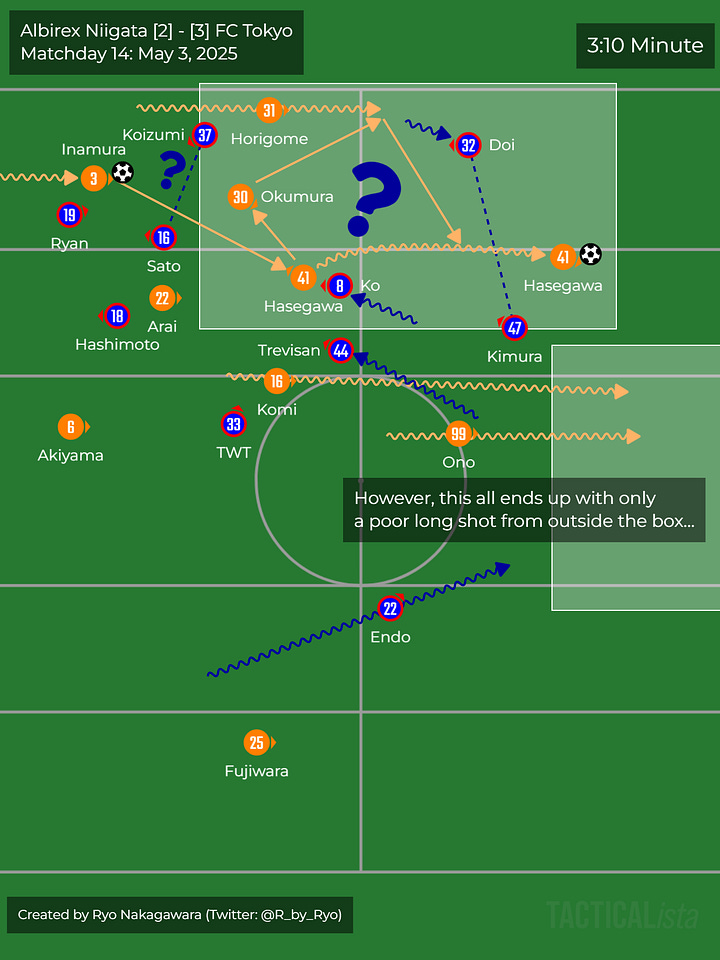


Due to all the issues at the back, it’s been very hard for Tokyo’s attackers to do anything of note… One positive thing I can say though is that Kein Sato has genuinely been very good, he is aggressive and runs hard in attack and defense. The only issue with him is that he’s been very poor at finishing chances but he at least gets on the ends of these chances in the first place (on top of creating for others) so I’m hoping he gets the rub of the green soon. It just goes to show how a change in context can completely change your view on a player as I was never impressed with him for the U-23 Japan National team, which is where I first encountered Kein Sato.
Marcelo Ryan has been pretty good in limited minutes but fitness issues has derailed his and FC Tokyo’s season so far when he should be starting every single game. His lack of defensive contribution is also a worry for a team that needs all hands on deck. Kota Tawaratsumida continues to flounder as despite his outstanding dribbling ability and technical skill, his end-product output is still notoriously poor. There are very clear reasons why I haven’t committed to sitting down and writing a scouting piece on him. Perhaps the national team call-up will give him the spark to improve…
The one big surprise of the season so far has been 15 year old Maki Kitahara. Either playing in the double-pivot or further forward he has shown a lot of quality and maturity in limited minutes. At the other end of the age spectrum, the return of Kento Hashimoto has been nice. He’s formed a decent enough partnership with Takahiro Koh in the middle of the park. Industrious as usual and I can’t really blame any of the double pivot players when they’re forced to fire-fight emergencies in defense constantly.
Keita Endo, when he's fit (very crucial caveat here...), has looked good but has been unfortunately shunted to Left Wing Back given the complete lack of transfer activity to fill the gaping hole there. Now, instead of getting Ryoya Ogawa, an actual Left Back with a Left foot, the club brought back Sei Muroya (Right Back) instead.
This goes into the issue of FC Tokyo buying players that are never fit or just not good enough in the first place. It’s such poor squad construction with clear gaps in various positions that haven’t been addressed in a long time. Everybody knew about Tsuyoshi Ogashiwa’s injury issues but the club spent not insignificant chunk of money on him and he has barely played in two seasons. Everton Galdino didn’t play particularly well on loan last year but the club decided to buy him permanently for a (reported) huge chunk of change! This is on top of keeping around players like Keita Yamashita (also injured throughout most of his time at the club) or perplexingly bringing back Koki Tsukagawa after barely appearing on loan at a poor Kyoto side last season. I won’t even get into the albatross that is Keigo Higashi… In the past week or so before this newsletter was released, several signings have been made (Motoki Nagakura, Kim Seung-Gyu, Alex Scholz) but they all come with large asterisks that make me worry.
In the pre-season FC Tokyo preview for the J-Talk podcast (the best and only English language J.League podcast) I talked about how my concerns with the appointment of Rikizo Matsuhashi was less with him than the squad wholly unsuited for his style of play. It is clear now that this has proven true (re-read all of the above…) but it’s quite startling to me how poor Matsuhashi himself has been as well! His management has been erratic with weird starting XIs, bench choices, and odd substitutions. There was also the incident of inexplicably starting a recovering Marcelo Ryan in a cup game… which Tokyo went on to lose anyway! All of which led to Ryan not starting and then getting (yet another) injury in the next league game a few days later!
It just seems like there's some weird curse or something in the club's DNA where players (even new arrivals!) just can not seem to patiently and effective pass out from the back in a consistent manner. Check my season reviews over the past several years, the FC Tokyo section is almost a copy-paste of the same issues every time! I imagine I'll be copy-pasting this same spiel in December. Fun, fantastic! After nearly 5 years of poor management, awful (or lack of) recruitment, confusion & miscommunication between players and management, Tokyo can't even get the basics right anymore, let alone try to play in a more "expansive", “attractive” style of play.
Albirex Niigata (19th, 16 Points)
3 Wins // 7 Draws // 8 Losses
Location // Stadium: Niigata // Denka Big Swan Stadium
Manager: Daisuke Kimori
19 Goals (13th); 27 Conceded (tied 20th)
16.10 xG (18th); 21.93 xGA (15th)
Top goal scorer: Motoki Hasegawa (6 goals)
Goalkeeper: Kazuki Fujita // Daisuke Yoshimitsu
Niigata underwent a lot of changes during the off-season with manager Rikizo Matsuhashi leaving for FC Tokyo alongside the departures of players like Motoki Nagakura, Thomas Deng, and Ryosuke Kojima. The surprise appointment of Daisuke Kimori, a coach with no prior managerial experience, raised eyebrows and Niigata only won a single game in the first 10 matches of the 2025 season. Despite two more wins since then, it still hasn't been smooth sailing with the team struggling in both attack and defense.

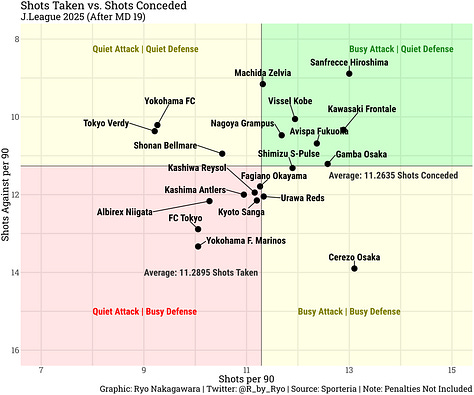
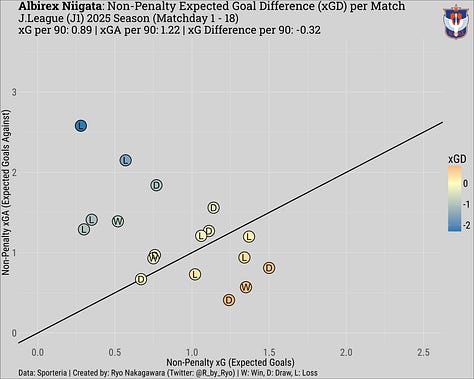
Ken Yamura has been decent on his return from loan down in J2 and his 4 goals only trail talisman Motoki Hasegawa's 6 so far for the orange swans this season. Keep an eye on whether Hasegawa's output drops as despite his 6 goals, it's coming from a really low number of shots and low xG value. Nevertheless, his ability to drive forward with the ball is a huge boon for this Niigata side needing to find ways to get closer to the opponent goal.
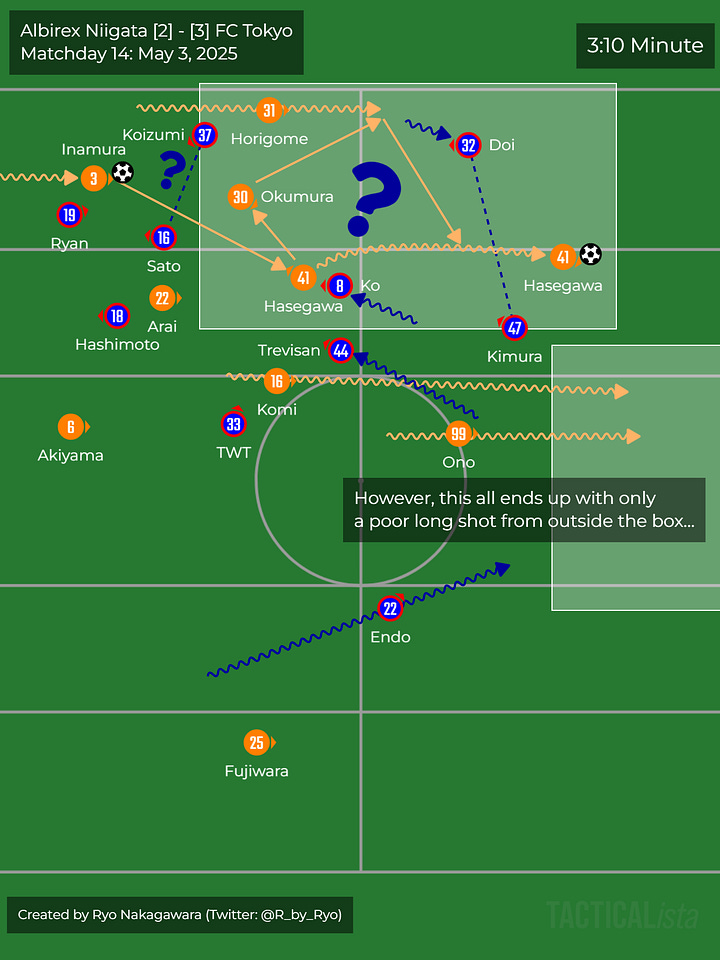

Yota Komi has been good in spurts but overall this attack is quite feeble outside the occasional moments of brilliance from the aforementioned players (NOTE: he has transferred to Kashiwa Reysol). Jin Okumura has been decent in limited minutes but hasn't quite been able to turn his technical skills into actual end-product though.
Niigata continue to be very tidy in possession but also continue on from previous seasons where they just don't seem to get anywhere with the ball past the middle 3rd of the pitch. Hayato Inamura & Hiroki Akiyama have both been very good at progressing the ball forward but more often than not, their passes go to waste once teammates enter the middle-3rd of the pitch, let alone the final 3rd. Despite having the 5th most average ball possession in the league, they are 13th in both final 3rd entries and opposition box entries while also 15th in shots per game.


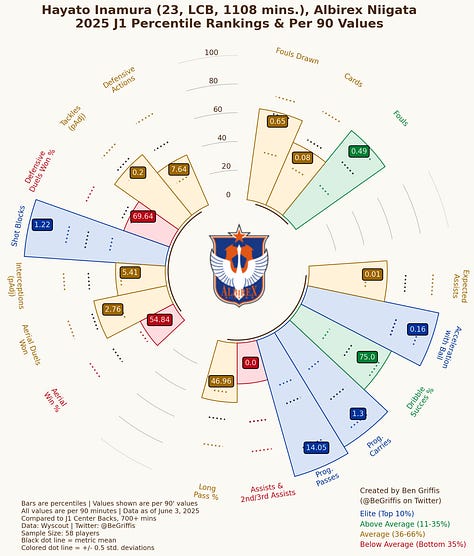
The defense has been predictably leaky, especially on set-pieces and crosses (29.2% and 16.7% of goals conceded respectively). It also got to the point that Kazuki Fujita, who was finally given a chance at the J1 level after several years out on loan, has been relieved of his duties by the veteran Yoshimitsu in the starting XI in the past month. Aussie veteran Jason Geria has been fairly decent though.


Niigata survived by the skin of their teeth last season alongside a feel-good League Cup final appearance but it's looking very likely that they'll get relegated especially as Nagoya Grampus & Yokohama F. Marinos have more capacity to improve as the season goes on.
Yokohama F. Marinos (20th, 14 Points)
3 Wins // 5 Draws // 10 Losses
Location // Stadium: Yokohama // Nissan Stadium
Manager: Steve Holland (to late April) // Patrick Kisnorbo
18 Goals (14th); 26 Conceded (15th)
15.91 xG (19th); 23.46 xGA (18th)
Top goal scorer: Daiya Tohno (5 Goals)
Goalkeeper: Park Il-Gyu
I didn't think Marinos could hire another manager worse than Harry Kewell but they managed to prove me wrong! Steve Holland's time at Marinos was extremely short as he was unceremoniously fired in late April, a week before Marinos' journey to the Asian Champions League knock-out stage in Saudi Arabia. To me, the logic of trying to stabilize the defense a lot more especially after the previous few seasons, was perfectly sound. Marinos definitely needed new ideas and balance. However, the execution has gone horrifically under the guidance of new director Tsutomu Nishino. On top of all this there are also overhanging financial issues over main sponsor Nissan that put a dark cloud over the Marinos faithful.


Marinos' famed possession-play has withered. A far cry from even just two seasons ago as the players now lose the ball and composure at the slightest bit of pressure. There just isn't that sense of rhythm and mutual understanding that had made Marinos such a potent and attractive team anymore.
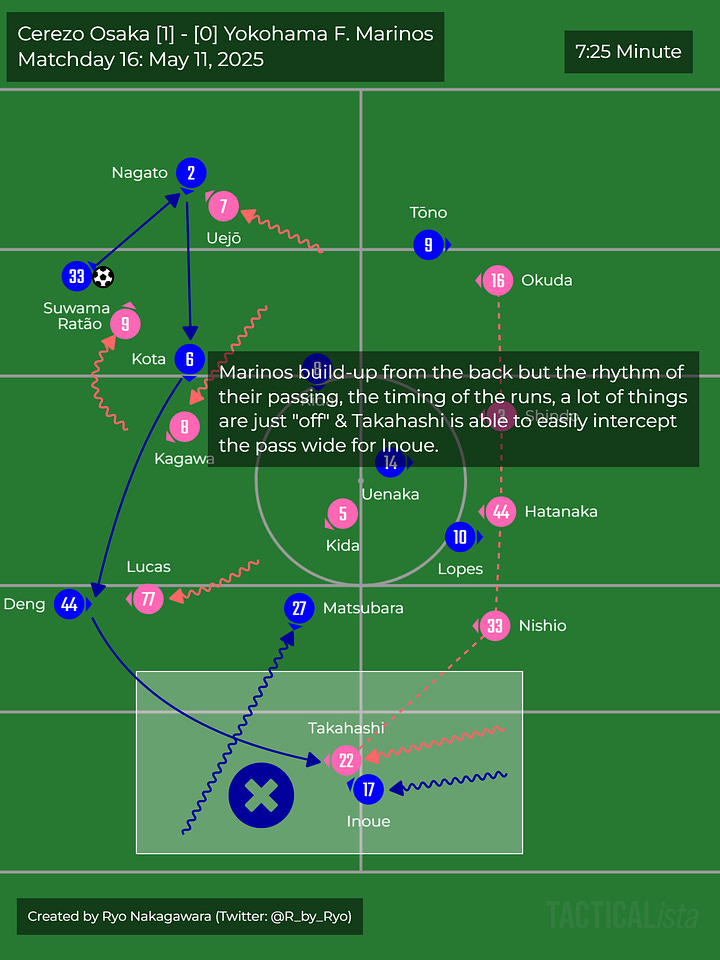

Up top the Brazilian attacking trio looking haggard and also simply not starting together anymore under both Holland and Kisnorbo. It seems age has really caught up to Elber while Anderson Lopes has only a solitary goal to his name so far! Fortunately Yan Matheus has continued to shine in adverse circumstances with 4 goals and 2 assists. In their stead, Daiya Tohno arrived from Kawasaki Frontale and has made a pretty good impact. His dribbling and finishing ability have allowed Marinos to claw back some points throughout the season as he leads the team with 5 goals. Marinos get the ball to him “somehow” and he dribbles and takes shots (of middling quality so we’ll see how his hot streak in front of goal lasts)!
Jean-Claude was one of the few players that looked decent until his injury really derailed the new-look midfield. Riku Yamane has been OK at least but he’s had a tough going with everything that’s going around him with captain Takuya Kida again having various injury issues.
On the defensive side, things are also fairly abysmal as Marinos. It’s fairly easy to play through Marinos’ press and the players do not seem coordinated at all. I’m really unsure why Marinos got rid of Takumi Kamijima just about when he was finally getting used to Marinos’ style of play. In general, it’s clear that they’ve tried to change too much too quickly.

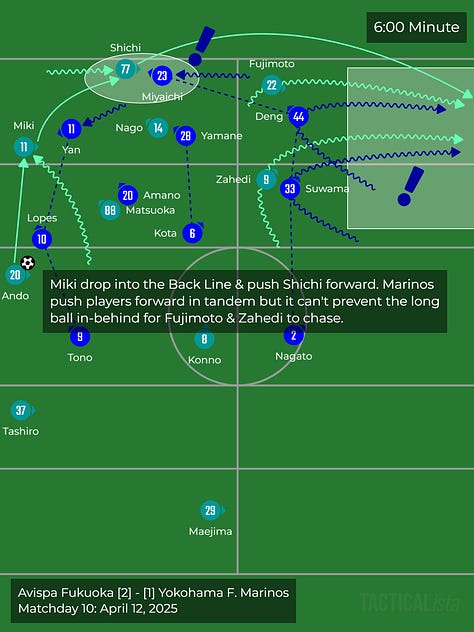

It’s not been a great season for Marinos as they have one of the league’s worst defenses on top of their neutered attack. They were dumped out of the ACL by Al-Nassr just a week after firing Steve Holland. There’s quite a few players in the squad now that you’d think belong to a J2 level team and not Yokohama F. Marinos. Some were bought with potential in mind and that they’ll be steady squad players until they improved but they haven’t done so. As such while a lot of the core stars of Marinos have aged, now their supposed replacements just are nowhere near the level required.
A ray of sunshine pierced the stormy skies after a thumping win against high-flying title-chasing rivals Kashima Antlers in late May and another resounding win against Machida Zelvia. Could this be the beginning of a massive turn-around in fortunes? This positive outlook has been squandered somewhat as Marinos lost against 4th division side Reinmeer Aomori in the Emperor’s Cup literally a day before I released this newsletter…
They remain one of only two teams to have never been relegated from J1. However, there are still many signs that this rich history might change come December 2025...
Squad Age Profiles
I changed the calculation of a squad's median age up a bit by simply taking into account only players that have played 50% of more of total possible league minutes. This is so when looking at the 'average' age of a team, we're doing a better job of considering players who are regulars in the team. I am not sure how other people might do it but from playing around with the raw data it looks OK, most teams have around 9~12 players that meet this threshold so I do think I'm capturing the right selection of players in any given team.
Anyway, here's the list of the U-23 players in the league with the most minutes played so far this season (filtered for those that have played more than 50% of total possible league minutes). You might want to keep an eye on these guys in the short-to-medium term. One of the simplest ways to judge a player’s quality is minutes played. It doesn’t matter how much talent you have or how much potential if, in the end, you don’t actually see minutes on the pitch to show it off!
Scoring Situations
Ideally, I would have data that concerns all shots or xG accumulated from different match situations as that would mean a much larger sample of data to power any insights (as goals are only the end result and may not give us information about a team's actual performance).
Team Shot Quantity & Team Shot Quality
In the previous few sections we got to know a lot about the goals that J.League teams scored. However, in a sport like soccer/football goals are hard to come by, they might not really accurately represent a team’s actual ability or performance (even if ultimately, it's the end result that matters). To take things one step further I was able to gather data from Sporteria on shot quantity to dive a bit more into team performances. I’ve reversed the order of some of the stats in these next few plots so that in all cases the top right is best and bottom left is the worst teams when looking at their respective stats.
So, what exactly is expected goals (xG)? Expected goals is a statistic where a model assigns a probability (between 0 and 1) that a shot taken will result in a goal based on a variety of variables and is used for evaluating the quality of chances and predicting players’ and teams’ future performances. A xG model only looks at the variables up to the point that the player touches the ball for a shot. Post-shot xG models covers the information about where in the frame of the goal the shot went (“post” as in all the information after the player touches the ball for the shot) but I won’t cover that here.
For some quick primers on xG check the links below:
The following two sections use xG data from Football-Lab. I’m not privy to all of what goes into their model but the explanation page on their website (in Japanese) tells us about some of the information they used:
Distance from goal?
Angle from goal line?
Aerial duel?
Body part used?
Number of touches? (one touch, more than two touches, set plays, etc.)
Play situation? (Corner kick, direct/indirect free kick, open play, etc.)
So, the usual variables that you might recognize from other xG models are being considered. Combining shot quantity and shot quality numbers gives you a much better idea about a team’s performance on either side of the ball.


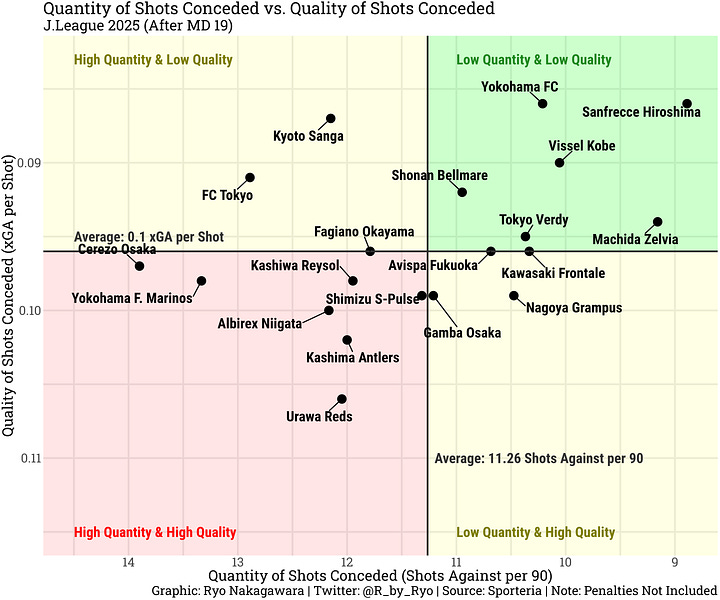

xG Difference
xG Difference is pretty much the same thing as Goal Difference except that we use xG and xGA rather than goals and goals against. This lets us see very quickly which teams generally outperformed their opponents in terms of quality of chances created to quality of chances conceded based on a xG model. This time around I also included the team's results inside the bubble points. So it's easier to see whether a team that had a positive xGD in a specific match couldn't manage to win the game or vice-versa. You ideally want to be below the diagonal line and winning (W) these games as well.
Five Match Rolling Averages
Goals vs. Goals Against
xG vs. xGA
xG vs. Goals
xGA vs. Goals Against
Summary
The J1 league in its usual fashion has been a rollercoaster full of teams underperforming and overperforming in equal measure. It’s been interesting watching the various teams navigate an everchanging environment in world football with the international involvement of J.League teams in the Asian Champions League and the Club World Cup.
There’s been a lot of teams shifting to a Back 3 // Back 5 in recent years as they look to stabilize their build-up and settle their defense at the same time. There’s also the difficulty of finding Japanese Center Backs who are both simultaneously athletic and technical enough to do both in a Back 4 setting as well (on top of the fact that those player profiles will immediately get plucked by European teams). There’s lots of different flavors of Back 3s and different profiles used at Wing Back which has been interesting to see. I’m hoping for more of a changing-of-the-guard in terms of goalkeepers across the J.League as teams tend to employ very old veterans. Alexandre Pisano winning a spot for Nagoya Grampus, even if due to injuries to others, is hopefully a sign of more to come (especially as the young Taishi Nozawa is rumored to be off to Europe).
If you’ve read this far, thank you! This is a work done out of love and the newsletter continues to be free for all. If you want to show your appreciation, please share it far-and-wide. If you want to go even further you can always drop me a tip.
Thanks for reading!


